Saying a prayer for a retiring dean
At the end of the Oct. 9 service all honorary clergy of the cathedral joined

Scott Pittendrigh and his wife Sarah Donnelly. Pictured are, from left,
Rev. Victoria
Deacon Bill
Dean Scott

At the end of the Oct. 9 service all honorary clergy of the cathedral joined

Scott Pittendrigh and his wife Sarah Donnelly. Pictured are, from left,
Rev. Victoria
Deacon Bill
Dean Scott
SASKATOON — The congregation of the Cathedral of St. John the Evangelist in Saskatoon gathered to celebrate Dean Scott Pittendrigh’s retirement, after his last Sunday service on Oct. 9.
At the conclusion of the service, all of the honorary clergy of the cathedral joined bishop Chris Harper in blessing Dean Scott and wife Sarah Donnelly.
Following the blessing, Scott and Sarah processed up the centre isle and cut a celebratory retirement cake together. Stan Hodgins, a long-time parishioner, presented a stained-glass
Continued on page 5

This year marks the 10 th anniversary as bishop of Missinippi for Bishop Adam Halkett.
I remember his election. It was at the Senator Allen Bird Gymnasium and was full of Indigenous voting delegates.
There were two running for the position.
Rather than counting ballots, this election was won by the number of people lined up behind their candidate of choice.
They lined up behind Adam along the side wall and the back wall.
He won.
On the evening of his consecration, all the bishops who attended and the congregation were invited to a hall for a feast.
A head table was set up for the dignitaries with Adam to be the guest of
honour, but no one could find him.
They finally found him in the back of the room sitting with his family.
This was an indication of the humility of this new bishop.
For his first five years as bishop, I was his secretary. He had a lot to learn in the beginning, as every new bishop does, and so he went to England to learn to be a bishop.
After his time spent in England learning the ropes he came back more confident in what he was to do.
He was given an honorary doctorate from the College of Emmanuel St. Chad a

year later.
The position of a Diocesan Indigenous Bishop means a lot to the Indigenous congregations in the diocese.

Adam continued with meetings of the Indigenous council, elders, James Settee College sessions, general assemblies and visiting and supporting his parishes and clergy.
Unfortunately, due to stress leave, he was not able to attend the October synod, but will receive a certificate of congratulations signed by all the synod delegates and others, and a gift of a birch bark picture and a beautiful off-white stole with red embroidery.
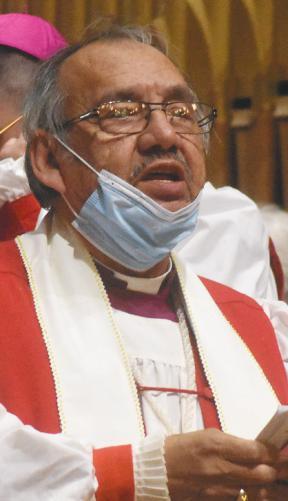
Two priests from the Diocese of Lichfield in England visited their companion Diocese of Qu’Appelle in September. Rev. Nicola Busby and Rev. Sara Humphries were amazed by the size of the diocese and the distance between places in Saskatchewan.
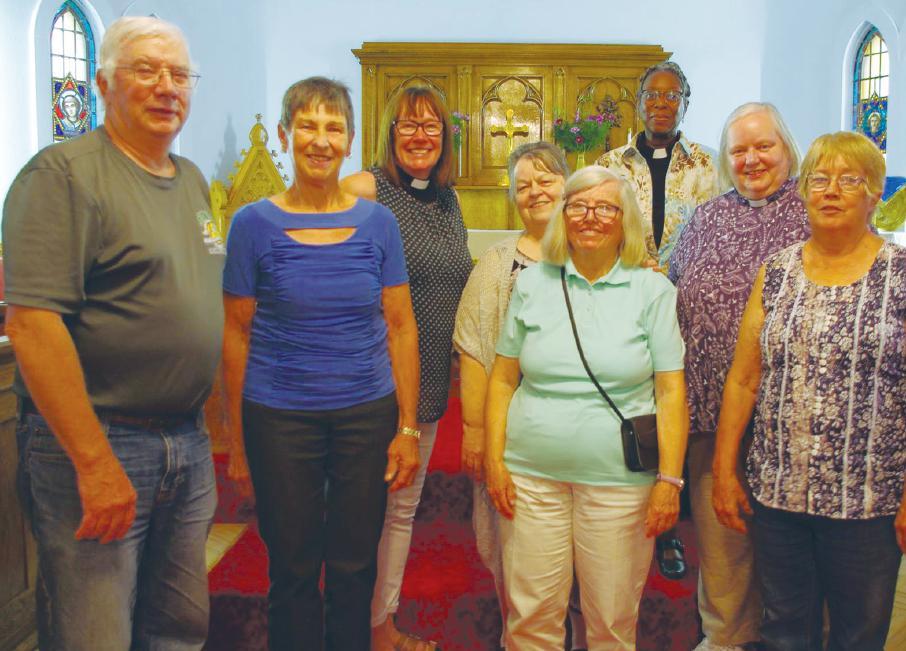
They attended an evening service at St. Boniface and St. Lawrence Anglican Church in Assiniboia, and had their picture taken with the congregation after the service.
The simple answer to this question is this: we do not (and cannot) fully understand the presence of Christ in the Eucharist.
Add to that the fact that as Christians, we don’t all agree on the presence of Christ in the Eucharist.
Some (like Roman Catholics, and some Anglo-Catholics) believe in transubstantiation, the theological concept that the substances of the bread and wine offered at the Eucharist change into the Body and Blood of Christ, while the accidents (or what it looks like) remain as they had previously been.
There are others (like Lutherans) that believe in sacramental union, where Christ is “truly and substantially present in, with and under the forms of the consecrated bread and wine, so that communicants eat and drink the holy body and blood of Christ Himself as well as the bread and the wine.”
Ask an Anglican, and the common thought is something changes in the Eucharist, but how that change occurs is a mystery.
While I believe that the exact mechanics of the presence of Christ in the Eucharist remains
a mystery to us mere mortals, I believe that the presence of Christ in the Eucharist is real and very present.
The Eucharist is more than a mere memorial to me (although when we do partake in the Eucharist we proclaim the Lord’s death until He comes).
I believe that that presence of Christ as
Eucharist, and how I could always count on that to help strengthen me spiritually to be in seminary.
How did it strengthen me as I worked through all the changes that come with being in seminary, though?
Well, to be frank, I didn’t really know how the Eucharist strengthened
I knew that Christ is present in the Eucharist, but if you were to press me for more details, I wouldn’t have been able to give them to you. The presence of Christ in the Eucharist is very much a mystery, and theologians have been spilling ink on it since the early days of the Church. I imagine that they will continue to do so until that day when Christ appears on Earth once again.
found in the Eucharist has strengthened me throughout my life.
Let me tell you a story about the Eucharist in my own life.
I remember back to my seminary days at Huron College at Western. As any seminary-trained priest can tell you (and will, if you let them), seminary is a time filled with highs and lows.
I remember on more than one occasion where I was feeling those lows that come with the seminary experience.
As I was going through those lows that happen from time to time, my thoughts turned to the
me as I did this work.
I just knew that after attending the Eucharist, I felt better and strengthened to do my work in the world. If you had asked me how it all worked, I probably would have said, “It’s a mystery to me.”
I knew that Christ is present in the Eucharist, but if you were to press me for more details, I wouldn’t have been able to give them to you.
The presence of Christ in the Eucharist is very much a mystery, and theologians have been spilling ink on it since the early days of the Church.
I imagine that they will
continue to do so until that day when Christ appears on Earth once again.
However, until that day where we will meet Jesus Christ face to face, we can and will meet Him in the Sacrament of the Eucharist. This presence is a mystery, but in this case, a little mystery isn’t a bad thing.
When we lean into the mystery of Christ’s presence in the Eucharist, whenever we receive Him in the Bread and the Wine, our relationship with the Holy and Undivided Trinity is strengthened, and we are strengthened to go forth into the world to love God with all our heart, soul, mind and strength, and to love our neighbour as we have first been loved by God.
The next time you approach the altar to receive the Body and Blood of Christ, may you be renewed by Christ’s presence in the Eucharist, and may your soul be fed so that you can live a life that reveals the Father’s love to the broken world around us.
Rev. Matt Koovisk is the Editor of The Mustard Seed of the Diocese of Brandon. He also serves as the Rector of St. Mary’s, Virden, MB; St. Mark’s, Elkhorn, MB; St. John’s, Reston, MB; and Christ Church, Melita, MB.
He has been formed by life and education at UBC, Huron at Western, L’Arche Daybreak, and Trinity College, Toronto.


Published by the Dioceses of Saskatchewan, Saskatoon and Qu’Appelle. Published monthly except for July and August.
Whole No. 292, Vol. 51, No.4 A Section of the Anglican Journal
SUBSCRIPTIONS
For change of address, undeliverable copies and subscription list updates, contact:
• Your parish
• e-mail: circulation @national.anglican.ca
• Or send to Saskatchewan Anglican, c/o Anglican Journal, 80 Hayden Street, Toronto, Ont. M4Y 3G2

RATES
$10 in Canada $17 outside Canada
SUBMISSIONS
Submissions for the February issue must be received by the diocesan editor no later than Dec. 23. All pictures must be sent as JPEGS and 1 MB (megabyte) in size.
CONTACT INFORMATION
Managing Editor: Jason Antonio SKAnglicanEditor@gmail. com 1501 College Ave Regina, Sask., S4P 1B8 Phone: 306-737-4898
Qu’Appelle: Joanne Shurvin-Martin joannesm@myaccess.ca 6927 Farrell Bay Regina, Sask., S4X 3V4 Phone: 306-775-2629
Saskatoon: Peter Coolen ptrcoolen@sasktel.net 820 Avenue I South, Saskatoon, Sask., S7M 1Z3 Phone: 306-244-0935,
Saskatchewan: Mary Brown mary1949brown@gmail.com Box 25, Shellbrook, Sask., S0J 2E0 306-922-5159
Advertising agent: Angela Rush saskatchewan.anglican.ads@ gmail.com 905-630-0390
Published from 59 Roberts Place Regina, Sask., S4T 6K5
Why is the presence of Christ in the Eucharist “a mystery”?From left are Ken Hamilton, Lynn Sangster, Rev. Nicola Busby, Trudy Kwasnicki, Carolyn Henderson, Archdeacon Catherine Harper, Rev. Sara Humphries, and Marjorie Hamilton. Photo by Deacon Arleen Champion
My name is Michael, I’ve got a nickel (Clint Holmes). Some of us may remember the 1972 hit, “Playground in My Mind.” I recall it for those particular lyrics in the chorus.
My name is Michael and while I have many other titles, some serious, some silly, some over the top, that is my name. It is foundational that our old Catechism begins with that question, “What is your name?”
The children answer each giving their own Christian name or names. The Catechism begins then with our identity in Christ, with our Christian names, given to us in baptism.
It begins with who we are as members of Christ, children of God, and inheritors of the kingdom. In teaching the Catechism the first lesson always has to begin with the distinction between the surname(s) we receive at birth and the Christian name(s) we receive at our rebirth.
I would recall myself and all of you to that distinction for I cringe as I hear folks introduce themselves ever more frequently confusing their title for their name. Every time I hear, “My name is “Dr. James Otto” or “My name is Rev. June Black,” I fear the spiritual and emotional and
relational dangers of such confusion.
There is a power to a personal name and an intimacy as well. Recall the scene at the end of John’s Gospel account
when Jesus says her name, “Mary,” and she turns around and knows Him and calls Him her Lord and Teacher.
He knows her and she knows Him, on a first name basis. Titles can be important as signs of respect and honour, but they do not identify us.
My mother did not like nicknames; there were no Mikes or Bobs in our house, and so I am Michael and my brother is Robert.
Our Lord, as many people in tight-knit communities with large families and many common names used nicknames often. Peter (Rocky), Bartholomew (Bart’s Boy) and Boanerges (Sons of Thunder, which, while it sounds like the name of a Rock Band, was Jesus’ nickname for James and John, the sons of Zebedee) were all nicknames Jesus gave His
followers.
There is still in the New Testament an insistence on the actual given name.
John the Baptist is called the Prophet, the Forerunner, the Voice, Elijah II, but remember as they were about to name him Zechariah after his father, the old man took a tablet and wrote deliberately, “His name is John.”
So it is with our Lord Himself. He has countless titles, nicknames and honours, many of which we remember in Advent and at Christmas: Son of David, Son of Mary, Son of God, Son of Man, Christ the Lord, Teacher, but He has one single personal name, Jesus.
"He shall be called Wonderful, Counsellor, The Mighty God, the Everlasting Father, the Prince of Peace. They shall call His name Emmanuel, which being interpreted is, God with us, but thou shalt call His name Jesus: for He shall save His people from their sins."
Jesus means literally, The Lord God saves, and this name proclaims the divinity of the child born of Mary and that He is the Saviour of the world.
This is the name at which every knee shall bow from lowly shepherds to the high and mighty magi, and it has been a custom since ancient times for Christians to bow their heads slightly at the holy name of Jesus.
To hear my name on the lips of Jesus, to hear Him call, Michael, is my highest and eternal hope.
I invite you to reflect on the Lord’s holy name this Advent, Christmas and Epiphany and on the holiness of your own name on what His name means and what your name means and how to honour both.
The pop song “Playground in my Mind” sounds like a nonsense nursery rhyme, especially the bits about Michael buying candy with a nickel but it begins sadly and quietly:
When this old world gets me down and there’s no love to be found/I close my eyes and soon I find I’m in a playground in my mind/Where the children laugh and the children play/And we sing a song all day.
That playground in all of our hearts and minds, that playground is the hope of all humankind, that playground is the kingdom of God, where the children laugh and the children play and we sing a song all day.
In that playground Jesus is King of the castle.
May you know, and hear, and enjoy that playground and kingdom in the celebration of Christmas, in your Christmas Communion and in the delightful and playful and tasty ornaments of our celebrations of Jesus.
In the spring of 2017, Angus Reid conducted a public opinion poll that examined the spiritual practices and beliefs of Canadians.
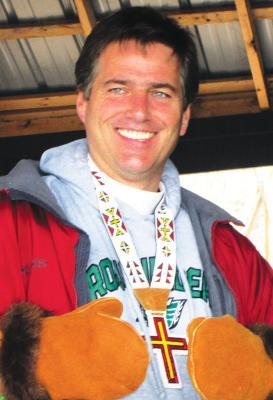
It suggested a full 30 per cent of Canadians fit into a category described as privately faithful–people who have no connection to a faith community, but believe there is a God, pray to God and (perhaps most astonishingly) want their kids to be taught about God by a recognized faith community ( https:// angusreid.org/religion-incanada-150).
This equates to roughly ten million people across
our country. How might churches reach these people? One thing is for certain. Churches will not reach them by focusing on themselves.
We need to begin to think and pray seriously, and plan creatively, so we can better reach people with the gospel.
We have so much to offer, but like beautifully wrapped presents stacked in a shop window, what we have can be just beyond the reach of the unchurched and dechurched person.
What would it look like for churches to rethink and tweak our lovely, cherished traditions of Christmas so people beyond our churches could enjoy them too as a first
seed of the gospel?
It would be amazing if Christians actively unwrapped their churches for their neighbourhood this Christmas.
Here are some practical ways churches can tweak what they already do at Christmas to help cultivate the new relationships that can be seedbeds for sharing the faith with the privately faithful, as well as explorers and seekers.
Pageants may be the ideal event to invite unchurched neighbours, friends, colleagues and family to since we already know from the Angus Reid poll that many of them want their kids to learn about the original
Christmas story.
So, with them in mind, plan to hold your pageant on a day and time when they are most likely to be able to attend with their kids — like Saturday or Sunday afternoon or early evening, just before Christmas.
Plan your greeting and some follow-up hospitality (hot chocolate on the lawn?) specifically with your unchurched guests in mind. But whatever you do, keep it simple and be intentional about advertising your pageant to the neighbourhood,
At the event itself be sure to provide info on other ways you can help their kids learn about God. For example, you could provide a cheat sheet on
How to Talk to Your Kids About God, or Answers to Questions Kids Ask About God. Build a relationship with the whole family by assuming their best intentions to help their kids explore faith. And above all, have fun together.
Since many unchurched people recognize the emptiness of a purely consumer-driven Christmas, invite people in your neighbourhood to join your volunteer prep, set-up and serving teams.
Set aside at least half your team roles for such folk and advertise early in the fall to begin to form a relationship with them.
PRINCE ALBERT — If you read the October Saskatchewan Anglian you would have read the article by Kathy Hawkins on page 12.
In her article she explains the logistics of Days for Girls.
Her vision was to partner with the women of the diocese to spread awareness, raise funds, sew hygiene kits and encourage local initiatives.
I would say her vision was achieved.
On Oct. 17 at St. David’s Church in Prince Albert there were over 20 women gathered to learn how they could help. Some of
the women were knitters, some had serger sewing machines and others had
Photo by Mary Brownregular sewing machines, and some had friends who sew!
Each girl will receive a Dignity Kit, which consists of a draw string bag, with a zip lock bag inside it, with a knitted washcloth, two pairs of panties, two shields, reenforced with a piece of polyurethane laminate fabric, that will attach to the panties and six standard serged liners.
Hawkins wants to take 300 of these kits to the Bishop McAllister College, in Uganda this February. That means she will have to have 300 drawstring bags, 300 knitted washcloths, 600 pairs of panties, 600 shields, and 1,200 standard serged liners by the end of January.
After going through
the instructions step by step, those interested were given individual bags with detailed directions, patterns, and a completed sample.
There were also rules about the kind of fabric to use and definite advice on what patterns and colour not to use.
So far Kathy has spent about $2,000 of her own money and has received $800 in donations to date.
The ACW Executive presented her with two cheques one from them and one from St. George’s Anglican Church in Prince Albert.

If you are interested in getting involved, please contact k.hawkins@ sasktel.net
g Saskatchewan Anglican online! Did you know you can read current and past issues of the Saskatchewan Anglican online? Visit www. anglicandiocesesaskatoon. com/saskanglican or on Facebook at www.facebook.com/ saskatchewananglican
g Please note that if you are considering attending any church service in person , please check on service availability and any requirements for preregistration that may exist. If attending services, please follow all the indicated seating, movement, distancing, masking, and sanitization instructions.
g Christ Church, Saskatoon presents its ACW’s annual “Joys of the Season:” Christ Church Saskatoon’s ACW will be presenting its annual “Joys of the Season” on Saturday, Nov. 26, from 11 a.m. to 2 p.m. at the parish hall, 515 28th St. West, Saskatoon. The event includes a Christmas Luncheon ($10 per person), and the sale of Christmas baking, turkey pies, puddings and poinsettias as well as great door prizes.
g School of Discipleship Ministry Preparation Program:
The Diocese of Saskatoon’s School of Discipleship Ministry Preparation Program is a part-time three-year licentiate. Students may take a course part way through the three-year cycle unless pre-requisites for a specific course are stated.
The first full complement for the ESC licentiate in theology is planned to be completed by spring 2023.
People wishing to take one or more of these courses should consult with the School of Discipleship co-ordinator.
People who sense a call to diaconal or priestly ordination will go through the diocesan discernment process at some point before the midway point. See the notices of the WECAN and Evangelism courses posted elsewhere in this issue.
If you have any questions about our Ministry Preparation Program, please contact the School of Discipleship co-ordinator, the Rev. Dr. Trish McCarthy, at tmccarthy@sasktel.net, 306-370-8378 and see the course listings posted elsewhere in this issue.
g Courses at the College of Emmanuel: The College of Emmanuel & St. Chad welcomes inquiries and applicants for its courses. For
information on courses available from Emmanuel & St Chad and through the Saskatoon Theological Union, please contact their office at 306-975-1550
g Evangelism I and II Conferences: The Saskatoon School of Discipleship will be holding two conferences on evangelism in 2022.
The first, instructed by the Most Rev. Greg KerrWilson, will take place on Friday, Nov. 4 from 7 to 8 p.m. and Saturday, Nov. 5 from 9 a.m. to 4 p.m. The second will be instructed by the Rev. Amy Bunce and the Rev. Dr. Trish McCarty on Friday, Dec. 2 from 7 to 9 p.m. and Saturday, Dec. 3 from 9 a.m. to 4 p.m.
Provided by hybrid (ZOOM and at a Saskatoon location TBA). To register contact Rev. Dr. Trish McCarthy at saskatoonschool ofdiscipleship@gmail. com or 306-370-8378. Please also see the notice posted elsewhere in this issue.
g Safe Church Workshops: The Preventing & Responding to Abuse courses will be offered on Nov. 30 (Part A) and Dec. 7 (Part B). Please see the notice elsewhere in this issue for more details.
College of Emmanuel: The College of Emmanuel & St. Chad welcomes enquiries and applicants for its courses. For information on courses available from Emmanuel & St. Chad and through the Saskatoon Theological Union, please contact their office at 306-975-1550
g Evangelism II Conferences: The Saskatoon School of Discipleship will be holding two conferences on Evangelism in 2022 instructed by the Rev. Amy Bunce and the Rev. Dr. Trish McCarty, on Friday, Dec. 2, from 7 to 9 p.m. and Saturday, Dec. 3rd, from 9 a.m. to 4 p.m. Provided by hybrid (ZOOM and at a Saskatoon location TBA).
To register contact the Rev. Dr. Trish McCarthy at saskatoon schoolofdiscipleship@ gmail.com or 306-370-8378. (Please also see the notice posted elsewhere in this issue)
g The Very Rev. Scott Pittendrigh retired as Dean of the diocese and rector of the Cathedral of St. John the Evangelist effective Oct. 15.
A retirement celebration was held for the Dean at the cathedral after his last Sunday service on Oct. 9, and
on Oct. 21, a retirement dinner was held in the cathedral. (See article elsewhere in this issue).
Sara Donnelly, Scott’s wife, also retired from her position as pastoral assistant at St. John’s.
Scott and Sarah will continue to reside in Saskatoon for the next few years as Sarah continues in her role as program director at Queen’s House Retreat and Renewal Centre.
g The Rev. Canon Glen Huntington Ash died in Saskatoon on Oct. 26. A celebration of life service was held in Glen’s memory at Emmanuel Anglican Parish, Saskatoon on Nov. 5.
g To be included in a timely manner, brief notices should be supplied to the associate editor by fax, email or “snail mail” by the end of the month, one month before the month in which the insertion is desired (i.e. February entries will be in the April issue).
Detailed and longer texts of upcoming events will not be included in this section, but should space allow, could be the subject of articles and notices elsewhere in the Saskatchewan Anglican.
Continued from page 1 image of the steeple at St. John’s, on behalf of him and late wife Patricia.
On Oct. 21, a retirement banquet to honour Scott and Sarah was attended by over 100 parishioners and friends who enjoyed a catered meal on tables in the main aisle and transepts of the cathedral.
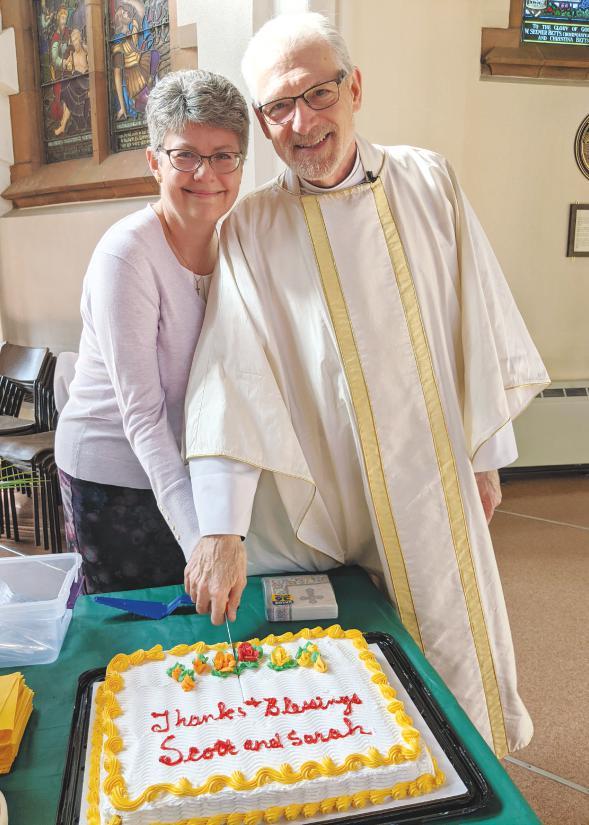
This beautiful setting was a fitting venue to celebrate a decade of ministry at St. John’s and 25 years of priestly ministry that began in that very place, when Scott was ordained by thenBishop Tom Morgan.
Greg Schulte, cathedral organist, provided music for much of the evening.
The church wardens, Ginny Blake and Heather Olson, led the program and presentations, including flowers and money from the congregation and a gift of a blanket from Bishop Chris and Tracey Harper.
Sarah put together a slide presentation of the significant people and events of Scott’s time as Dean. Bishop Chris also offered a blessing as they embark on the next chapter of their lives.
Jane Crosby, responsible for the planning and coordination, led a crew of over 20 parishioners who filled roles from setting up to making desserts and washing dishes.
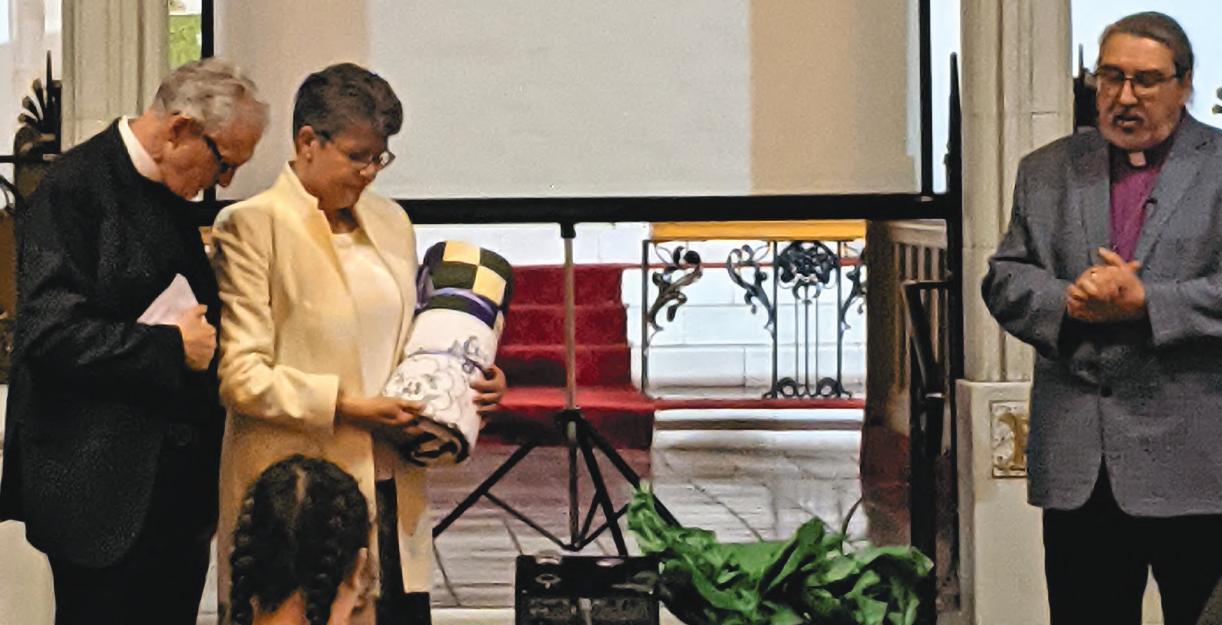
Dean Scott began his ministry at St. John’s in 2012, just as the cathedral was celebrating the centenary of its cornerstone and embarking on a major restoration project.

He leaves just as the parish is about to celebrate the end of that decade-long restoration project with over $3 million in work.
He built a reputation for St. John’s as a Cathedral for The City, reaching out and welcoming citizens through civic services. He led the congregation through the challenging period of the pandemic and saw the beginnings of its revitalization.
His wife, Sarah Donnelly, has served as pastoral assistant at St. John’s. Dean Scott paid special tribute to her throughout his ministry.
Scott and Sarah will continue to live in Saskatoon for some years as she continues as program director at Queen’s House Retreat and Renewal Centre.
For the Dean’s retirement dinner on Oct. 21, more than 100 parishioners and friends enjoyed a catered meal on tables set up in the main aisle and transepts of the Cathedral.


Itrust you are all making the most of the rich Advent worship, readings and prayers designed to keep us wide awake and to make us ready for The Lord’s return, just as Jesus said in the gospel for the First Sunday of Advent (Matt. 24:42-44).
There are several references to the Holy Spirit in our Advent readings to help with our wakefulness and readiness. The first was in the Isaiah 11 reading for Advent Sunday:
A shoot shall come out from the stump of Jesse,/ and a branch shall grow out of his roots. /The spirit of the Lord shall rest on him, /the spirit of wisdom and understanding, / the spirit of counsel and might,/ the spirit of knowledge and the fear of the Lord. / His delight shall be in the fear of the Lord (Isa. 11:1-3).
The “shoot,” of course, is Jesus. And upon Him the Spirit of the Lord, the Spirit of wisdom, understanding, counsel, might, knowledge and a fear of the Lord that is delightful, shall rest.
That Spirit is, of course, the Holy Spirit, with whom Jesus was duly filled to overflowing at His baptism; who, said John the Baptist in the gospel on the same day, baptizes with the Holy Spirit and fire (Matt. 3:11); and who breathed the Holy Spirit on the disciples (John 20:22) after He rose from the dead. He’s still breathing it on people.
As I’ve said before, when we were baptized and confirmed, prayers were said over us so we would be filled with and empowered by the Holy Spirit.
So as we watch and wait this Advent, know that that same Spirit of the Lord, of wisdom, and all the rest, is upon us,
to keep us spiritually awake and ready for His return (and our Christmas celebrations if He doesn’t return first).
Just as Jesus was physically conceived by the Holy Spirit in His mother, Mary (Matt. 1:1821), Jesus is spiritually conceived by the Holy Spirit in you and me.
By her obedience, Mary brought Jesus into human history for the whole world. By our Advent wakefulness, readiness and obedience we can make space for Jesus in our own hearts and lives as well as help usher Him into the lives of those around us.
Two other thoughts about wakefulness and being ready. First, that intriguing reference to “delight” in the fear of the Lord in Isaiah 11:3. How does one do that? Fear, for you and me, might have too many associations with wrath and the stern, demanding, jealous God of terrible aspect.
Yet, Advent watchfulness must also involve a healthy fear with honest self-awareness. Awareness, such as, that our sin is deceitful (Heb. 3:13), lurks at our doors and over which we must learn to rule (Gen. 4:7).
The good news is, as we will hear in the gospel on the Fourth Sunday of Advent, Jesus came to save us from those sins (Matt. 1:21). Delightfully good news. Watch for it.
Second, and finally, here’s my Advent prayer for all of you, from the First Sunday of Advent’s epistle: May the God of hope fill you with all joy and peace in believing, so that you may abound in hope by the power of the Holy Spirit. (Rom. 15:13)
May your Advent be rich and your Christmas be merry and bright with the light of Jesus!

Jesus calls us to:
“Go into all the world and proclaim the Good News to the whole creation.”
- Mark 16: 15
Anglicans from over parts of Manitoba, Saskatchewan, Alberta, British Columbia and the Council of the North to learn new skills

Module Two: Friday, December 2 from 7 to 9 p.m. and Saturday, December 3, 2022 from 9 a.m. to 4 p.m.
Hybrid Delivery: Location TBA & ZOOM
Registration or Questions: Trish McCarthy 306 370 8378

trish.mccarthy@saskatoontheologicalunion.ca Include your full name, diocese, parish, phone number, snail address and email

This course is being offered by the Saskatoon Diocesan School of Discipleship equipping people for lay and ordained ministries.


Few pastors will face a disaster the likes of which happened on James Smith Cree Nation and in the nearby town of Weldon during the Labour Day weekend.
The stabbing deaths of 10 people and injuries of 18 more on Sept. 4, and then the ensuing four-day manhunt for accused brothers Myles and Damien Sanderson, shocked the nation and left the community deeply traumatized.
On Sept. 5, Damien, 31, was found dead from injuries that appeared not to have been selfinflicted. On Sept. 7 Myles, 32, was arrested and died soon after being taken into custody.
As the tragedy unfolded and news crews arrived, Wilfred and Theresa Sanderson led the community in a moving prayer service via
Facebook Live.
The in-person gathering for that evening had been cancelled due to the security lockdown.
Sorrow etched on their faces, Wilfred and Theresa ended with, “We love you all. Love one another, forgive one another, help one another. We can get through this together – mamuwe.”
James Smith Cree Nation is 200 kilometres north of Saskatoon in the Diocese of Saskatchewan. The Anglican presence is strong on James Smith, led by Bishop Michael Hawkins and local clergy Wilfred and Theresa.

The Sandersons are both spiritual and community leaders, not just for those who regularly attend church but for all who live there. During those terrible days and since, they have continued the sacrificial ministry that characterizes the work of so many northern Indigenous clergy.
If you have never visited a northern Saskatchewan reserve, you may not immediately grasp the magnitude of the effect of an event like this.
James Smith Cree Nation is a tightly-knit community of around 1,900 people, with most members being somehow inter-related.




In fact, the Sandersons, while not close relatives, share a surname with the accused. In the days following, hundreds of bereaved family and community members would attend wakes for those who died — Thomas Burns (23), Carol Burns (46), Gregory Burns (28) Lydia Gloria Burns (61), Bonnie Burns (48), Earl Burns (66), Lana Head (49), Christian Head (54), Robert Sanderson (49), Wesley Petterson (78) and Damien Sanderson.

Community leaders spoke powerfully about the tragedy. Darryl Burns, brother of Gloria Burns, in a remarkable gesture, embraced the wife of Damien and urged forgiveness.
He said, “Her husband is accused of killing my sister. Our family is here to forgive. This woman shouldn’t have to bear that kind of guilt and shame and responsibility.”
While the details will never be fully known,

there are now indications that Myles, not Damien, may have been the main perpetrator.
At a gathering on Sept. 8, Chief Wally Burns said, “I’m trying to hold myself together with the words that need to come out … . We ask three things of the governments.
“We ask that we have our own tribal policing; we ask for awareness in addictions; we ask for treatment centres.”
As news spread across the country and then the world, the Archbishop of Canterbury sent a handwritten letter to the chiefs of James Smith expressing his deep sadness and the connection he felt to the tragedy, having just visited the community on his tour this past June.
“I write with enormous sorrow and sympathy at the news of the utterly horrendous attacks you have suffered.
“Having been with you so recently, I can imagine the appalling trauma. You are deeply in my prayers. At this moment you face the most demanding of tests, to comfort the bereaved.”
Poignantly, a note of condolence from Queen Elizabeth II also turns out to have been her final public letter. She said, “My thoughts and prayers are with those recovering from injuries and grieving such horrific losses. I mourn with all Canadians at this tragic time.”
Noting this, Bishop Hawkins said, “As the news cycle moves on from the tragedies in northern Saskatchewan to the news of the death of our Sovereign, Queen Elizabeth II, let us not forget that the grief and trauma remains here, that one of these stories is filled with violence and sudden death and the other of a dear, sweet soul who lived a most fruitful and long life, and finally that one of the Queen’s last and gracious acts was to extend her condolences to the families and people of Weldon and James Smith Reserve.
“Let us extend our sympathy and keep extending it. We mourn her (death) who mourned with us.”
Thanks to The Anglican Planet for providing this story.

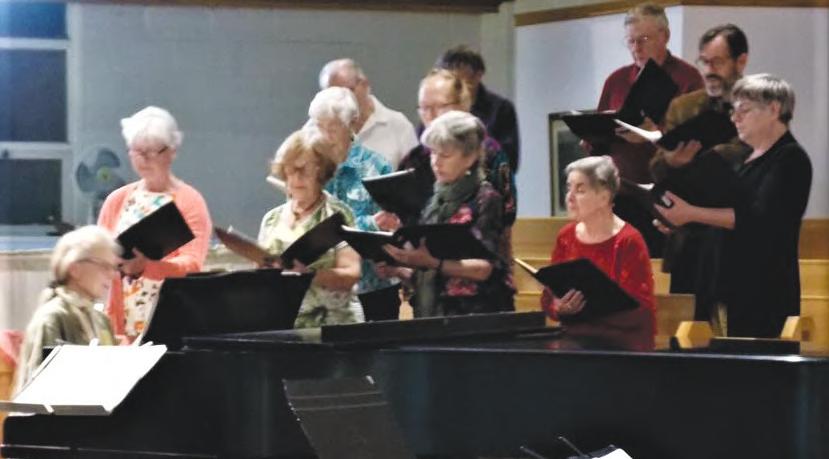 By the Rev. Mark Kleiner
By the Rev. Mark Kleiner
SASKATOON — Like all of us, Saskatoon’s Christ Church Anglican spent much of those early COVID-19 years deferring celebrations and other occasions, even while maintaining weekly worship (albeit at times solely online).
With the eventual easing of restrictions, an eager anniversary committee earmarked three days from Sept. 23-25 to celebrate the parish’s 115th anniversary.
OK, maybe "115” doesn’t customarily get the fullon glitz and glam callin-the-fam anniversary treatment — but who’re we kidding? These last couple years have taken their toll, and a celebration seemed truly in order.
To that end, the church hosted a Friday night concert organized by long-time resident organist Renee de Moissac, featuring a wide range of talent, including a song performed on a handmade hurdy gurdy, and a rare performance by 92-yearold cellist extraordinaire Klara Belkin (veteran of the Winnipeg Symphony Orchestra).
On Saturday, the parish welcomed passersby to stop in for a chili lunch.
At the same time, the church video store, NUTFLAKES, maintained normal business hours, albeit with an additional note of festivity in the DVD-renting air (“May you celebrate to the betamax!” chortled one wellwisher on the way out the NUTFLAKES door, satchel of movie selections in hand).
Along with the chili,
brand-new Saskatoon home baking business Baby Bear Bakes paid their respects to Christ Church by proffering a “quiet launch” (not that quiet, as word of the 115 festivities spread through the neighbourhood like wildfire), debuting their wares with a to-die-for sampling of gourmet cupcakes.
That evening, the Christ Church basement hall, the original worship site for the first 47 years in its church history, hosted the grand anniversary gourmet banquet.

Well-wishers dined on fare that included a vegan option of balsamic-glazed portobello mushrooms stuffed with parsnip and potato puree; and for the meat dish: Za’atar-spiced roasted pork loin with pork au jus.
The celebrated sides included mixed green salads with congregants’ surplus garden veggies, roasted surplus garden root veggies, “Ian’s famous gingered butternut squash,” scalloped potatoes and onions, roasted beets and steamed beet leaves with lemon straight from Renee’s garden.
Catherine Engel did (at least) double-duty as both feast visionary and certified sommelier, serving Coppermoon Crisp White Blend and Jackson Triggs Merlot (when asked whether she was saving the best wine for last, she assured patrons every glass served would be “top drawer”).
and delectable cupcakes, along with the piece de resistance, a feature anniversary cake, 115 years in the making, and well worth the wait.
The following morning, any lingering fatigue from the previous night’s revelry utterly dissipated by the time the worship service’s opening hymn, “Unto Thy Temple, Lord We Come,” rang through the sanctuary.
top of the service), jammed into pews alongside other cherished guests and, of course, the Christ Church faithful for this jubilant time of worship.
With the strains of the recessional hymn, “Hallelujah! We Sing Your Praises,” still echoing, worshippers made their way downstairs for a closing luncheon hosted by the Christ Church ACW.
For dessert, Baby Bear Bakes unveiled beautiful and delectable cupcakes, along with the pièce de résistance, an anniversary cake, 115 years in the making.

For dessert, Baby Bear Bakes unveiled more equally beautiful
A veritable “who’s who” of regional ecclesiastical royalty, including Bishop Rod Andrews and Mrs Jacqueline Plante, and Fr. Bernard de Margerie (“The man who has done at least as much for ecumenism in Canada as Jimmy Carter has done for peace in the Middle East,” noted Christ Church Pastor Mark Kleiner at the
And just like that, the 115th anniversary festivities drew to a close, with beloved Christ Church Deacon Rev. Peter Coolen noting, “We can only celebrate so long, as we have the next 115 years to get ready for!”
If they’re anything like the last 115 years, they promise to be a wild, blessed, and faithful ride indeed!
The Rev. Canon Glenn Huntington Ash passed into the presence of the Lord sometime during the night of Oct. 26 at the age of 95.
Glenn was born in Edmonton, Alta. on April 5, 1927, to Neina and Sydney Ash. At the age of 12 his family moved to Peace River, Alta. While in Peace River he met his lifelong love, Adelaide and, in 1947, they were married.
They had four children: Katherine, Ann Marie (Owen Nicklin), Jonathan (Karlene) and Norman (Sheila). They were blessed with 10 grandchildren and seven great-grandchildren.

Glenn felt the call to the Anglican priesthood, a church he claimed was the church of his heart.
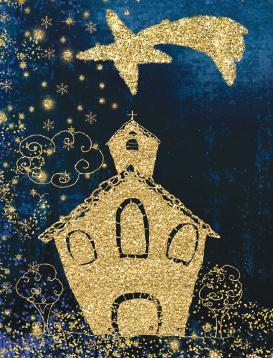
Submitted
Rev. Arthur Anderson died Oct. 31, at age 85.
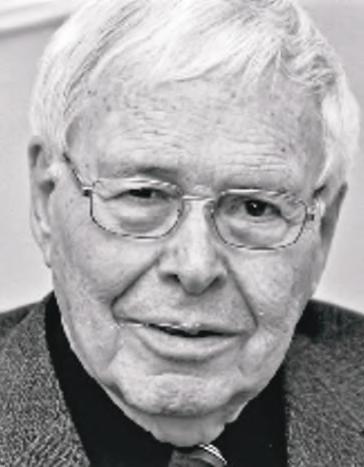
He was born on George Gordon First Nation, and attended residential school. After 29 years in the military, he graduated from the College of Emmanuel and St. Chad with a B.Th. in 1988.
He was ordained deacon by Bishop Eric Bays in May 1988, and priested that December. He served as assistant priest at St. Paul’s Cathedral from 1988 to 1993.
In 1993 Anderson was appointed rector of Plain and Valley Parish, served there until he retired in 1999.
He was appointed diocesan co-ordinator of Native Ministries from 2001-03. In 2008, Anderson was inducted as diocesan elder at the George Gordon Education Centre.
The funeral was held at St. Paul’s on Nov. 7. A full obituary will appear in January.
He received his licentiate in theology from the College of Emmanuel and St. Chad, was ordained to the priesthood on Dec. 9, 1956, and later attended St. Augustine’s College in Canterbury, England.
On his return to Canada
with his family, Glenn served for five years in the Diocese of Athabasca in Colinton, Beaverlodge and Athabasca, and then served as rector from 1969 to 1981 in the Diocese of Saskatoon at St. James, Saskatoon.
In 1970 he was collated as a canon in the Diocese of Saskatoon.
In 1982, he transferred to Diocese of Saskatchewan and served as priest-in-charge at Nipawin, where he served until he and his wife Adelaide retired in 2004.
After retirement he served in the Diocese of Qu’Appelle in Outlook, Milden and Beechy and returned to Saskatoon and St. James (now Emmanuel Anglican), where he served as honorary assistant until his death.
Glenn was known as the Friendly Giant. Glenn loved to sing, and many people will remember his beautiful bass voice in various choirs, especially The Refiner’s Fire at St. James.
He and Adelaide shared a passion for social justice that continued as their ministry in retirement, which was the reason why he was named a canon emeritus
The celebration of life for Glen was held on Nov. 5 at Emmanuel Anglican, Saskatoon.
Please hold his children, grandchildren and greatgrandchildren in your prayers and your gratitude for the many gifts Glenn left with us.
Donations in Glenn’s memory may be made to PWRDF of the Anglican
Church of Canada or a charity of your choice. Condolences may be left for the family at www. saskatoonfuneralhome. com
PRINCE
ALBERT —Discipleship was the theme of the 70 th Synod of the Diocese of Saskatchewan held from Oct. 14-15 after being postponed twice due to COVID-19 complications.
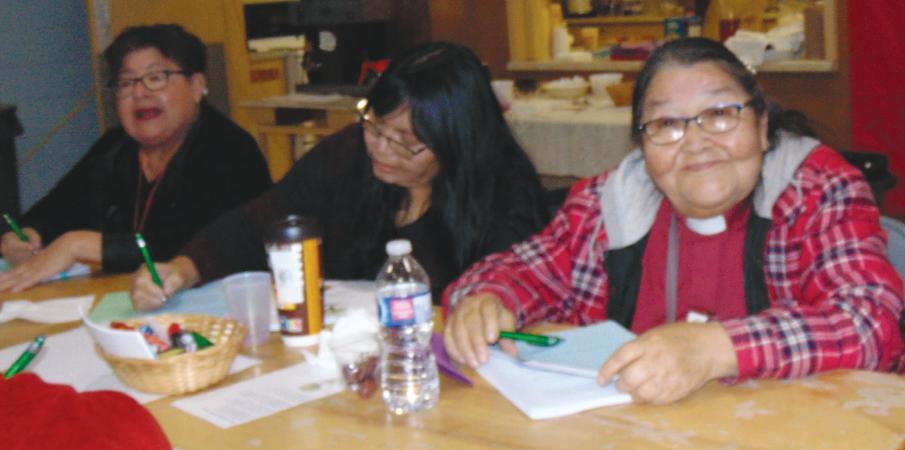

Delegates attended the opening Eucharist in St. Alban’s Cathedral, which was followed by the reading of part 2 of the Bishop’s Charge.
Bishop Michael Hawkins began by saying he wanted this evening to remind us that our calling is this and only this, to follow Jesus and to become more and more like Him.
Disciples making disciples it is a commonplace definition of the church. Only disciples can make disciples and if we want to make disciples, we need first to become disciples, to follow as disciples to grow as disciples.
The six disciplines of disciples are: Weekly Worship – Daily Prayer and Bible Reading –Christian Living – Spoken Witness to Christ –Serving in the Church and the World – Giving for the Work of the Church –(from Part 1 handed out earlier).
Disciples are student followers of Jesus Christ. In baptism we were enrolled into His school. Discipleship is not new; the Apostles are first and always called disciples. We were disciples before we were called Christians.
What is a bishop, an archdeacon, a warden, a vestry member, a deacon, a lay reader? A disciple, and if not that then nothing. Jesus’s first two commands of repent and believe and His next call to “Follow me.”
Jesus says to all the distracted, to you and me at the outset and at the end, “You follow me.” This is our call, this is all our hope, this is all our life and our eternal life, to follow Jesus.
Remember always that baptism represents unto us our profession; which is, to follow our Saviour Christ, and to be made like unto him.
In 2011 the late Majesty our Queen spoke of her
faith in the Saviour this way, “Although we are capable of great acts kindness, history teaches us that we sometimes need saving from ourselves –from our recklessness or our greed. God sent into the world a unique person –neither a philosopher nor a general.
“Forgiveness lies at the heart of the Christian faith. It can heal broken families, it can restore friendships and it can reconcile divided communities. It is in forgiveness that we feel the power of God’s love.”
One of Bishop Hawkins’ deepest wishes for us as his bishop is that we would honour one another, love and support and forgive each other as we have so readily and so often loved,
supported, and forgiven him.
There is a clerical and episcopal dependency in the diocese that is common in missionary diocese and is part of our history for good and ill, but that dependency can also lead to scapegoating and to a treatment of our bishops and clergy, which can be dishonourable.
Anglicanism is not clericalism; it is a lay movement. Common prayer took the liturgy from the priest and gave it to the people, the common people.
The diocese, your congregation requires lay leadership, lay worship, lay prayer, lay witness, lay examples, lay ministry, lay tithing.
We need to raise up our own leaders, lay and ordained. He rejoices that two of the deacons we shall make priests in St. Alban’s on St. Andrew’s Day, are born and raised in Saskatchewan, that Bishop Adam continues to raise up and train vocations for ministry.
But, how many of our bishops, with the happy exceptions of Bishops Tom Morgan and Adam Halkett, have their roots in this soil? Recently Bishop Adam celebrated the 10 th anniversary of his consecration, and I am glad to express to him our congratulations as well as our appreciation.
The bishop requested the synod to confirm the desire and commitment
for a 2023 prayer conference with a theme of discipleship and for synod or its executive to designate resources and to form a committee to plan what he hopes will return to being an annual event.
As we face financial challenges in the diocese and congregations, he wanted to highlight how these raise fundamental questions about a common vision and about committed stewardship.
Our lack is not one of resources or riches or people; we have them in abundance. No, our lack is for a vision.
This lack is there in our congregations where everyone tries to re-make the church in their image and to their taste.
It is there in our regions where what can only be described as cannibalism has often been suggested as the future of the Church, it is there in clerical and lay power struggles and mutual blaming. It is here in us as a bishop and synod.
We need humility and maturity to seek from the Lord a common vision, mamuwe, for our diocese and its parishes and congregations, for episcopal ministry and diocesan administration, for a growing selfdetermining and accountable indigenous
Continued from page 10 ministry, for a focus on our mission that has always been to share the Gospel of Jesus Christ in the northern half of Saskatchewan.
Is there a need for mission teams of indigenous and nonindigenous lay and ordained ministers to form and visit around the diocese?
In his time in the diocese before and after becoming bishop, Bishop Michael has held out stewardship, joyful and generous giving, stewardship education and commitment as a necessary part of our life and of every church year.
Except for some recent and generous bequests, there has been very little success raising funds in the diocese for the diocese.
Lack of mission, lack of support for leadership and lack of trust in financial management are clear causes for a lack of resources.
If there is a lack of mission, spend some time in prayer and discussion together discerning a common vision.
If there is lack of support and trust for leadership, rebuild that, show some humility, listen to people, apologize.
If there are concerns about financial management, address them head on and quickly.
Show accountability. Vision, leadership, management: with these three and a touch of boldness you will find the resources you need.
Over the past 22 months the bishop has been thankful for the diocese, its people and congregations, the executive committee, chancellor, treasurer, Archdeacon Hoskin, Barb Wirsta and Annette Benard who have all been extraordinarily generous, kind, compassionate, patient, and supportive.
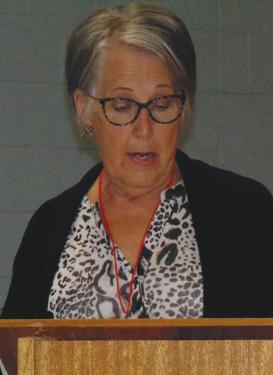
He returned to work this spring for the fourth time working up to halftime, which was not
manageable for his mental health, and he began experiencing disorienting confusion again.
He feels at times burdened and guilty that he is not able to give his ministry and work and the diocese what they need and deserve.
After prayer and consultation with Kathy, his physician and psychologist, he has decided that he will resign as bishop of the diocese effective April 30, 2023.
There are three things he wanted to lay before us.
Hope and vision: We are saved by hope and condemned by despair and
crippled by anxiety. We should adopt a helmet law for the diocese and our helmet would be the hope of salvation.
A vision of committed disciples would draw us together in mission and love.
Executive secretary and diocesan management: Is there a need for the synod to find an executive secretary before he resigns for the sake of overlap and continuity?
Episcopal and pastoral oversight: Is the idea of sharing three dioceses a way forward
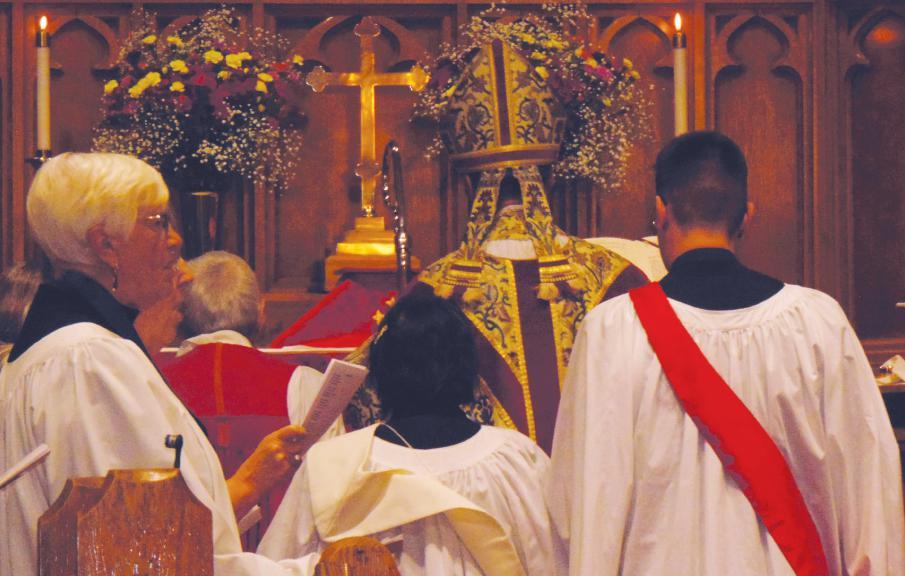
for us in ministry and mission? is one future of the diocese to have an Indigenous bishop as the diocesan bishop and perhaps for Indigenous ministry in all of Saskatchewan, with a nonIndigenous archdeacon and executive secretary?
There are a variety of configurations for us to consider, including sharing with Brandon, Athabasca as well as Saskatoon and Qu’Appelle.
The bishop proposed the following motion be made: ‘That for the next three years this Synod delegates to its Executive Committee and its prayerful discretion the right to request an Interim Bishop from the Metropolitan.’
Bishop Michael invited everyone in the diocese to join with him in making the following as part of our daily prayer for the next three years.
Draw your Church together, O God into one great company of disciples, together following our Lord Jesus Christ into every walk of life, together serving him in his mission to the world and together witnessing to his love on every continent and island.
Through him who lives and reigns with you, Father, and the Holy Spirit, one God, now and forever. Amen.
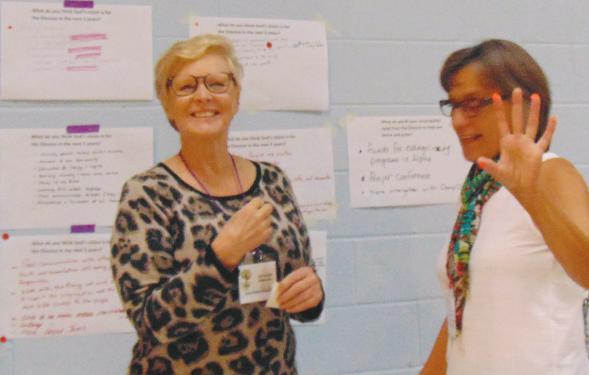 By Mary Brown
By Mary Brown
PRINCE ALBERT — As part of Bishop Michael Hawkins’ vision of committed disciples that would draw us together in mission and love, delegates were asked to take part in an exercise about the following three questions:
What do you think God’s vision is for the diocese over five years?
What do you value the most about our diocese?
What do you and your congregation need from the diocese to help you thrive and grow?
There were eight tables participating in this exercise. Each group put their answers on three large pieces of paper and presented their findings to the whole group. All the
large papers were put on the wall and participants were given coloured sticky dots to adhere to their favourite answers.
Overall, the answers to the questions were similar and it was wonderful to see how everyone was in sync.
The top answers (by number of dots) were:
Question #1 – Healing ministry (mental health, suicide), acceptance and inclusion of all, increase the expectation of lifelong discipleship, reconciliation, remember why we are a diocese, a church that tells its own story, educating our youth.
Question #2 –Leadership in all areas bottom to top and top to bottom, closeness of bishop to our congregation, accessibility and honesty, James Settee College, our unique place in the Anglican Church of Canada, the preservation of the BCP, the ways the
indigenous and nonindigenous work together.
Question #3 — more integration with Camp Okema, prayer conference, funds for evangelism programs, access to more learning opportunities, ways to and ideas to get people into the church, more communication between parishes and congregations, more Gospel Jamborees.
This session was very uplifting. It shows how we all share the same vision and want to work to it. The more we gather and talk about our successes, trials and tribulations, the more we become one in spirit. Even if you were not a delegate, you are welcome to attend as a visitor and share in the comraderie of fellow Anglicans.
REGINA — After the lay delegates were gathered in St. Paul’s Cathedral, the diocesan clergy and officials had processed in, and the opening hymn was sung, Dean Mike Sinclair spoke. “I’ve waited a long time to say these words, ‘Welcome back to your cathedral!’”
The synod of the Diocese of Qu’Appelle had not been held in person since October 2017. To meet canonical requirements, a very short synod was held on Zoom on Nov. 27, 2020.
The 84 th session of the Synod of the Diocese of Qu’Appelle took its theme from John 11, in which Jesus raises Lazarus from the dead.
In the Bishop’s Charge to Synod, Bishop Helen Kennedy drew some
parallels to Jesus calling Lazarus out of his tomb, to the church emerging from the lockdown, which was necessary to
keep people safe.
“We emerge into a very different environment … from two and a half years ago. You emerge from
this very difficult time with a new bishop … .
“I know that you have all worked so very hard to hold this ship together; for that I am grateful.
“This diocese has a strong foundation, and the past couple of years have been extremely challenging … and there is no guarantee that we are out of choppy water yet.”
The bishop referred to the restrictions and fears and chaos brought by the pandemic, like the grave clothes that bound Lazarus.
Jesus is calling us out of that tomb and we must “figure out how to live again in Christ,” said Kennedy. “… But we are going to need to go together as one body.”
She referred to the first reading, Jeremiah 29:11-14, in which God tells the prophet that if
the exiled people search for God with all their heart, God will be found and will restore your fortunes and gather you from all nations…and bring you back to the place from which I sent you into exile
“In everything, we need to seek God,” said the bishop, “and offer our will and our energy to be the church God is calling us to be.”
At the conclusion of her powerful sermon, Kennedy repeated that she did not know what the future will hold, and that she is committed to seek God’s will and be led by the Spirit.
“Together with the wisdom of the saints, we will build on the strong foundation that is the Diocese of Qu’Appelle, and claim the life that God in Jesus is calling us out to do.”
REGINA — The first session of the diocesan synod began shortly after the opening Eucharist on Friday evening.
Official greetings were brought by MLA Gary Grewal on behalf of the premier of Saskatchewan, and by Coun. Bob Hawkins on behalf of Mayor Sandra Masters. Hawkins, who was coincidentally a lay delegate from St. Mary, Regina, joked that the diocese is obviously more efficient than city council because they meet every week and never get all their work done, but synod meets only every three years and accomplishes much.
Archbishop Linda Nicholls sent her greetings by way of a short video and said, “… in the midst of rejoicing there will be uncertainties.”
The primate said that during the pandemic, the church has learned that we have resilience and fortitude for change. It also provided time to reflect on things, including the discovery of unmarked graves on residential school sites.
One of the first items of business in the first session was the announcement by Bishop Helen Kennedy that during the recent clergy conference, she had appointed Rev. Cheryl Toth as a canon of the diocese.
She also announced that when canons retire,
they are to continue to use the title “Canon.” At this time, the three retired canons in the diocese are: Canon Blair Dixon, Canon David Nevett and Canon Cheryl Toth.
The committees that worked on the multitude of preparations for the 84th Synod were introduced and thanked. The chair of
the credentials committee then announced that 23 of the 27 eligible clergy were present and 41 of 48 lay delegates were present, so quorum had been met.
A time of silence was observed to remember all past synod members who had died since 2017.
The minutes of the short synod held in November
2020 by Zoom had been circulated in advance, and were approved.
Each session of synod included a video presentation called a Ministry Minute.
The first was on the topic of reconciliation and featured Bishop Riscylla Shaw of the Diocese of Toronto. She encouraged the members of synod to watch Stolen Lands, which she had worked on preparing.

This video, made by the Anglican Church of Canada and available on YouTube, describes how the Doctrine of Discovery was used by explorers and churches to justify taking land from aboriginal peoples around the world.
Shaw encouraged members to learn more about the last residential school to close in Canada, “right there in your diocese,” and to read and act on the Truth and Reconciliation Commission calls for action.

Following the video, Rev. Alex Campbell spoke in person.
“I’ve dreamed of many things, and heard a lot of talk, but not much action,” he said. “I’ve been
REGINA — Saturday was a very full day for delegates and participants Diocese of Qu’Appelle’s synod, held Oct. 14 to 16. Archdeacon Catherine Harper led Morning Prayer, and then the second sitting began at 9:15 a.m.
Bishop Helen Kennedy gave a brief report on the Qu’Appelle’s two companion dioceses. Lichfield has had a very long relationship with Qu’Appelle, since the first Bishop of Qu’Appelle was from Lichfield.
Kennedy reported that two clergy from Lichfield had visited Qu’Appelle shortly before synod, and they were amazed with the size of the diocese and the distances to be covered. In the Diocese of Muyinga (in Burundi) Bishop Pasible has retired and the diocese has asked for prayers as they enter a new era with new leadership.
Reports from all diocesan committees and organizations had been circulated in advance of the synod. These were officially received.
The second Ministry Minute featured highlights of the Living the Mission campaign, which has wound down.
The video showed the wide variety of work accomplished using money from this five-year campaign, from renovations, improvements and energy efficiency upgrades on many church buildings; many programs for
children and youth; support for initiatives overseas such as hospitals and bicycles for clergy; food security programs both local and beyond; scholarships; the Qu’Appelle School for Mission and Ministry; and salary for the diocesan youth missioner.
Rev. Susan Anholt commented that Living the Mission has made a difference locally, regionally and globally. As the campaign ends, a strategic plan for finances is being developed by the diocese.
In a video presentation, Kurtis Krug explained
the diocesan involvement with Will Power, a national public education campaign designed to inspire Canadians to think differently about charitable giving, and empower them to create positive change through their wills.
He referred the delegates to the website at www.willpower.ca and to the diocesan website at quappelle.anglican. ca. The video featured Krug, Bishop Kennedy, Archdeacon Canon Cheryl Toth, and retired Bishop Rob Hardwick.
Krug said, “Imagine what God could do with
your gift!” He spoke in person after the video and mentioned another method to give to the church by changing the beneficiary on a life insurance policy.
Bryan Sigurdson, chair of the finance committee, presented the Financial Report. The 2021 audited statements show that as at Dec. 31, 2021, the diocese reported $9 million of total assets and unrestricted net assets (retained earnings) of $500,000.
Assets have grown substantially over the last four years as a result of property sales, bequests and refugee funds under administration.
On the revenue side, Fair Share expectations were reduced in 2021 due to COVID-19 and have remained at that level for the 2023 budget. Although overall the parishes have done an outstanding job of meeting their Fair Share commitments, it is recognized that some parishes face significant financial challenges.
No more income will be realized from Living the Mission beyond 2022. A deficit budget for the diocese has been approved for 2023.
To maintain a healthy financial position going forward, the diocese will focus on investment returns, legacy giving, stewardship education and resources, and new fundraising initiatives.
A diocesan strategic plan is under development. That must come first. The financial plan will undergird the strategy for mission and growth.
The final slide that accompanied Sigurdson’s presentation said: We need
to pray and discern where God is leading us and how we can best do His work in the Diocese of Qu’Appelle.
Several delegates asked questions based on the number of parishes they see closing. Dean Mike Sinclair reminded everyone that the church is not just a group of people and a bunch of buildings.
“When things die, God resurrects,” he concluded.
Archdeacon Wilma Woods said that long before a parish closes due to lack of money, the church should be working to raise up lay people and educate them in spiritual matters, so that if and when the parish closes the people will still have spiritual support.
Kennedy thanked Sigurdson for his 12 years as chair of the finance committee, and reported that Rev. Susan Anholt had agreed to chair that committee.
After a hearty soup and sandwich lunch, the third session of synod resumed.
Another Ministry Minute featured Camp Harding — renovations and upgrades completed this year, the Medieval Quest youth camp, lay people’s retreat, and plans for coming years.
Kennedy encouraged all parishes, deaneries and archdeaconries to consider using the camp venues.
There were questions about youths from the eastern end of the diocese attending church camps in Manitoba, while those in eastern Alberta could come to Camp Harding.
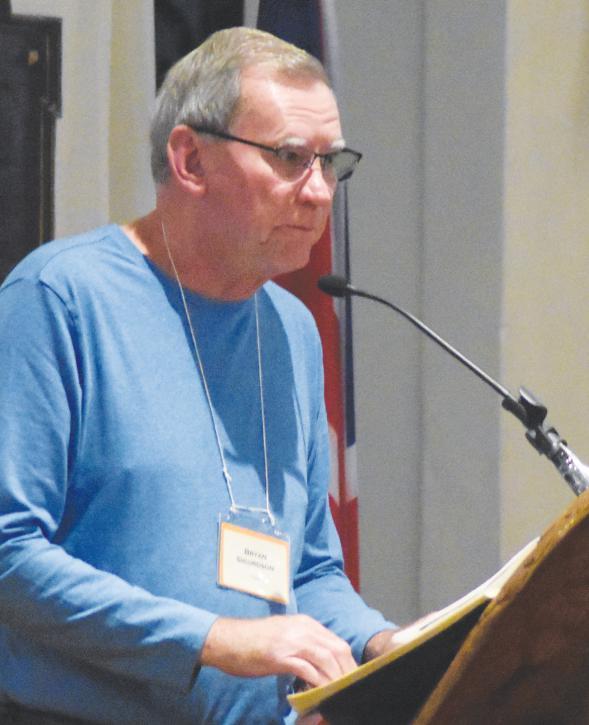
Kennedy said there have been conversations with neighbouring dioceses.
Continued from page 12 appointed priest of Indigenous ministry, but that’s not the end.”
He described how he had a long list of things he wanted to do when he was first appointed and was excited when the bishop announced that the former St. Matthew’s building in Regina would be used for First Nations ministry in the city.
But, he realized he needed to do his
homework first.
He said it was “eyeopening” to see all the kinds of churches and services available for Indigenous people in the North Central neighbourhood.
Campbell said he intends to continue to work with George Gordon First Nation regarding the unmarked graves discovered on the site of the residential school operated by the church for
the federal government.
He said the diocese is also working with the current school on Gordon’s.
Campbell stressed the need to build relationships with Indigenous people, and to build trust.
“Because of our history, our people are very nervous about the church.
… This is a huge mountain to climb,” he said.
He offered to work with parishes, to help them
learn about The Sacred Circle, about the history of residential schools, about the work of the Truth and Reconciliation Commission.
Campbell began and ended his talk by speaking in Cree.
He explained, “I know this is my calling. You, the parishioners, need to be the ones to work, and work together.”
Bishop Kennedy spoke briefly after Campbell,
and described her visit to Gordon’s First Nation to deliver a bike to Cory, who is now in Grade 6.
The bike was the prize for the competition to design the diocesan shirt for Orange Shirt Day.
The first day of the 84th synod ended –ahead of schedule – and participants were invited to a wine and cheese reception, hosted by Bishop Kennedy.
REGINA — Chancellor Tom Irvine carefully explained the need for several amendments to both the Special Act of Incorporation of the Diocese of Qu’Appelle and the diocesan canons. After some questions and discussion, all the proposals were passed.
First, Irvine explained that the diocese was incorporated by a Special Act of the Parliament of Canada, from 1885, and that act has never been amended.
The Act imposes restrictions on the diocese’s investment powers, which do not meet modern practices.
There are also restrictions on landholdings and on receiving bequests of land, which also do not meet modern practices.
The diocese will apply to parliament to amend the relevant portions of the Act, to bring it up to 21st century practices.
At the same time, amendments will modernize the language, by making it genderneutral, changing “Church of England” to “Anglican Church of Canada” and “North-West Territories” to “Saskatchewan,” and correcting some of the French language in the Act.
Irvine was asked how long this would take, and
replied it will depend on the Senate, but he is confident that it will not be a controversial application.
Other Canadian dioceses and General Synod have taken similar steps over the years.

The chancellor suggested it may take up to two years to make its way through the Senate.
For the four proposed amendments to diocesan canons, Irvine explained that the federal statue covering not-for-profit corporations (such as the diocese) requires the corporation to hold an annual meeting.
Synod meets every three years, and parishes hold annual meetings,
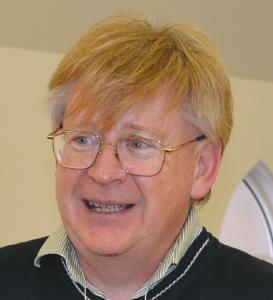
but these do not meet the requirements of the act.
Canon 2 will be amended to allow for the diocese to hold an annual information-only meeting, which will be open to all members and have a smaller quorum than synod.
No business would be conducted.
Canon 9 will be amended to clarify the ambiguity regarding quorum for executive committee meetings.
It will state that the bishop, dean and chancellor do not count
towards quorum, and will ensure that four elected members (two clergy and two laity) must be present at executive committee meetings.
Two sections of Canon 13 will be amended. Diocesan Council will be given power to direct investment companies recommended by the Board of Trustees, when Synod is not in session.
The requirement to keep all securities in a safe deposit box will be removed, as securities are recorded by modern electronic methods.
REGINA — Most of the discussions at the 84th Synod of the Diocese of Qu’Appelle aroused little controversy, but on Oct. 15, the topic of same-sex marriage was raised.
Delegates made arguments on both sides before voting on the motion: That the Synod seeks clarification from the Bishop of the Diocese of Qu’Appelle regarding ‘Word to the Church’ as a way forward, through a pastoral provision, for the local option for same sex marriage.
Lay delegates from St. Paul’s Cathedral, Susan Gorges and Lisa Markestyn, moved and seconded the resolution.
The background to the resolution was the vote at General Synod in July 2019, where proposed changes to the Marriage Canon that would allow same-sex marriage were defeated, by one vote in the House of Bishops, but passed by the clergy and lay houses.
Thus, the motion failed.
However, the document “A Word to the Church: Considering the Proposed Amendment of Marriage Canon XXI” was passed by the Council of General Synod on March 16, 2019.
This recognizes the diversity in the Anglican Church and that some bishops have authorised liturgies blessing same-sex marriages.
The document also states that bishops have
jurisdiction and authority over services and liturgies in their dioceses.
“A Word to the Church” was unanimously accepted by the 2019 General Synod; however, it is not a legally binding document and does not change either the marriage canon or the definition of marriage.
The resolution before synod asked the bishop to explain how “A Word to the Church” affects the diocese. Following the debate, the vote passed with four votes against.
Bishop Helen Kennedy said she had done some homework beforehand in preparation for possible questions on this subject.
She said the Anglican Church of Canada acknowledges there are differing understanding
of the Marriage Canon. The national chancellor has said that the wording does not prohibit same-sex marriage, and what is not prohibited is permitted.
Others, including some dioceses, do not agree, and say that marriage can only occur between a man and a woman.
Kennedy has previously said that she was at the 2019 General Synod (as a priest) and that she voted in favour of amending the Marriage Canon.
She reminded the delegates that General Synod agreed to continue working and standing together, despite the different understanding of marriage.
The bishop said there will be a “local option” for parishes in the diocese.
She said she will instruct all parishes to continue to discuss this topic at their next annual general meetings.
She will request each parish to vote whether or not to permit same-sex marriage or blessing in their parish.
Each priest in the diocese will be asked to write to the bishop, confidentially, stating whether he or she is willing to conduct a samesex marriage service.
The second resolution from the floor caused less controversy.
Presented by Diane Gingras of Immanuel, Regina, and Rev. Nancy Yee, interim priest of St. Mary, Maple Creek and St.
Continued from page 14 Stephen, Swift Current, it stated:
BE IT RESOLVED that the 84th Synod of the Diocese of Qu’Appelle calls upon the Anglican Church of Canada to continue to repudiate the Doctrine of Discovery as basis for seizing native lands and the abuse of human rights of Indigenous peoples; and
BE IT FURTHER RESOLVED that the Diocese of Qu’Appelle support the Anglican Church of Canada to work towards eliminating the Doctrine of Discovery as a means to subjugate Indigenous people of property and land; and
BE IT FURTHER RESOLVED that the Diocese of Qu’Appelle continue to work with the Indigenous peoples and communities to advance implementation of the TRC.

In speaking to the motion, Rev. Alexander Campbell gave a brief history of the Doctrine of Discovery, proclaimed by the pope in 1452, which stated that indigenous peoples were not human.
It stated that land that was not occupied by Christians was terra nullius (land belonging to nobody) and therefore could be claimed by European explorers.
In other comments, Rev. Diane Guilford, interim priest at Immanuel, Regina, encouraged everyone to read and study the Doctrine of Discovery.
She suggested looking on YouTube where an Anglican Church of Canada video explains how the doctrine was used to claim North America.
Bishop Kennedy said the ACoC has repudiated the Doctrine of Discovery.
Nora Wasacase, lay delegate from Yorkton, encouraged people to participate in the Kairos Blanket Exercise. She said the Doctrine of Discovery no longer applies, adding, “We (First Nations peoples) are not savages!”
On reparations, Kennedy said for years, the diocese has been trying to give land back to George Gordon First Nation. “The federal government has been dragging its heels, and it’s still not done.”
The vote on the Doctrine of Discovery passed with one opposed.
After a catered supper on Saturday, people stayed in the hall for a spirited game of trivia, with categories ranging from Science Fiction TV to the history of the diocese. The team named Neither Swift Nor Current (from Swift Current parish) was declared the winner. A concert followed in the church, with toetapping bluegrass music provided by Hummingbird Crossing.
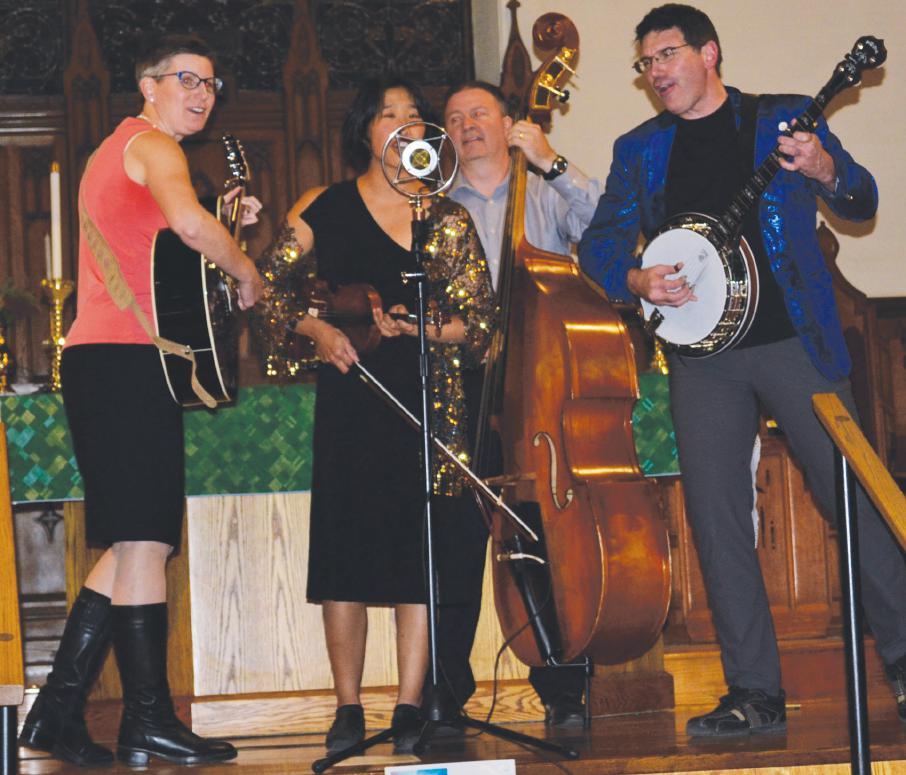
* indicates elected by acclamation.
Diocesan Council (8 clergy, 12 lay)
Rev. Michael Bruce* Rev. Winna Martin* Rev. Susan Page* Rev. Tracey Taylor* Four clergy to be appointed by Bishop
Jason Antonio*
Barb Compton*
Wendy Godfrey*
Bob Hawkins*
Anne Hill*
Linda Kapasky*
Six lay people to be appointed by Bishop
Provincial Synod delegates (3 clergy, 3 lay)
Rev. Susan Page*
Two clergy to be appointed by Bishop
Wendy Godfrey Linda Kapasky Alex McPhee
Jason Antonio will be an alternate delegate
General Synod delegates (2 clergy, 4 lay)
Rev. Michael Bruce* Rev. Winna Martin*
Wendy Godfrey Anne Hill Alex McPhee
David Saville
Jason Antonio will be an alternate delegate
Ecclesiastical Court of the Diocese (2 clergy, 2 lay)
Rev. Lauren Miller* One clergy to be appointed by Bishop Alex McPhee*
One lay person to be appointed by Bishop
Rev. Dr. Iain Luke, principal of the College of Emmanuel and St. Chad, speaks to synod.
REGINA — Rev. Dr. Iain Luke, Principal of the College of Emmanuel and St. Chad since 2016, opened his address to the 84th Synod of the Diocese of Qu’Appelle by saying, “What I most want to tell you is we’re still here — by the grace of God.”
In doing so, he acknowledged the many changes his college has experienced and the challenges that have tested its stability in recent decades. He also reassured the synod that the college now has a clear direction and strategies to achieve its present goals.
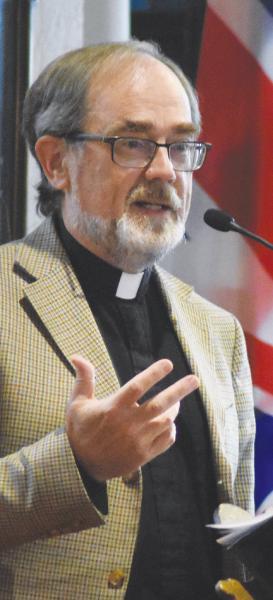
In a later conversation with Dr. Luke, I was reminded that many of those goals involve partnerships. First, there is the close working relationship with the Lutheran and United Church seminaries also affiliated with the University of Saskatchewan.
In fact, both Lutheran and Anglican colleges rent office and classroom space from St. Andrew’s College.
This has been a good arrangement in many ways, said Luke. The students like it, as they don’t have to crisscross the campus between classes, while their professors enjoy the opportunity to collaborate more fully
with counterparts from the other colleges.
Ironically, the move to St. Andrew’s in 2020 coincided with the beginning of the pandemic, so some benefits were delayed.
This year, however, most students and professors are back in the classroom, though a hybrid option is also available.
It’s important to all three members of the Saskatoon Theological Union (STU) that they avoid duplicating efforts, so they are working on a joint ecumenical curriculum for the master of divinity program.
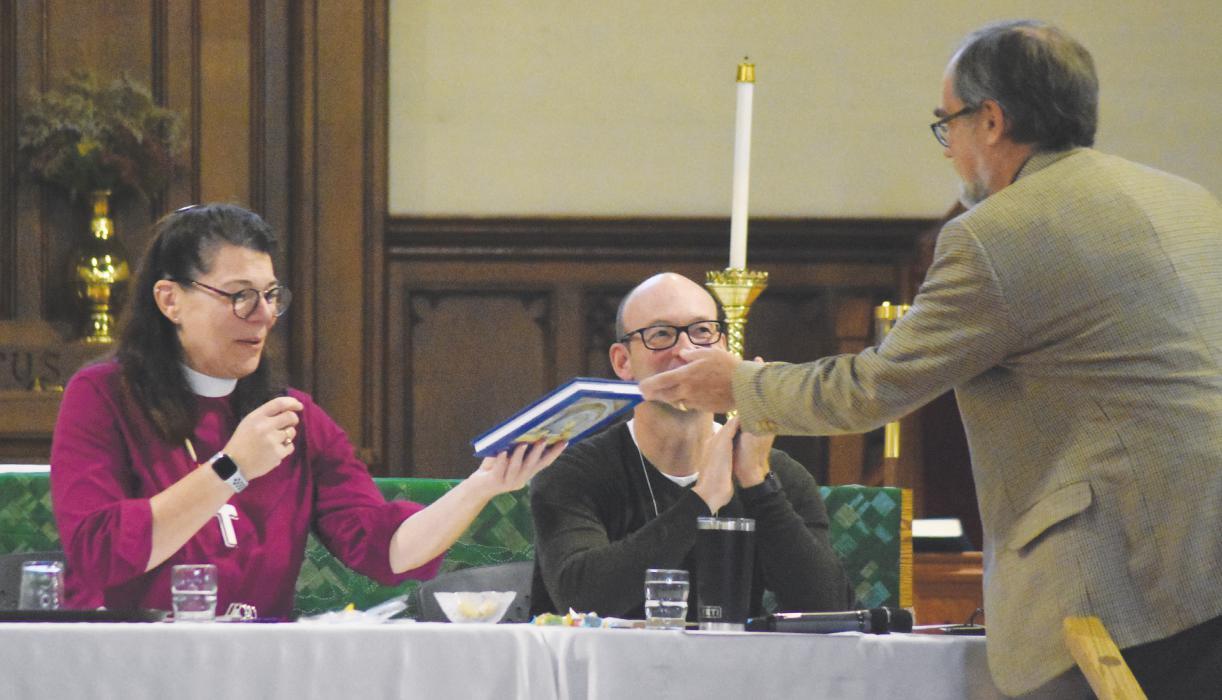
This acknowledges the increasing importance of ecumenism, particularly in rural but also in urban parishes. When they finish the new curriculum, the colleges will publish a joint calendar.
As Dr. Luke put it, “We are unlikely to have any graduates who won’t be part of an ecumenical collaboration at some point in their careers.”
Such ecumenical co-operation has been going on at parish and community levels for a
long time — but this is the first deliberate effort on the part of the STU to plan a whole program around such ministries.
This doesn’t mean denominations are no longer important. Dr. Luke described knowing our own identity and where we come from as the “assets” or “resources” we bring to
acknowledges geographical imperatives and the importance of the local context and seeks to “unleash the vast knowledge that local leaders already have.”
After all, locally trained clergy and lay people are called to ministry in, and particularly well suited for, the parishes they will serve.
At present, however, said Luke, “the Indigenous church has taken up a lot of its own training.” Still, the college is available to work with them.
such partnerships.
The ecumenical collaboration between the three Saskatoon seminaries is only one of the partnerships Emmanuel and St. Chad enjoys. The Qu’Appelle School for Mission and Ministry is another partner and part of a network of schools involved in training at the diocesan level.
In Western Canada, this network has come together in an organization known as the Western Education Collaborative Anglican Network ( WECAN), and the licentiate in theology program has come out of this.
This licentiate
Furthermore, few individuals can afford to go away for extended theological training; neither can dioceses afford to send them.
The college’s contribution to the partnership is in making academic resources available and “supporting ministry training that is sensitive to multiple grassroots settings, and reconstructing (the) licentiate in theology in a way which can be offered through diocesan programs in situ as much as possible” (Luke, in Bays and Powell*, p. 213).
From its beginnings, the College of Emmanuel and St. Chad has focused on training Indigenous people for spiritual leadership, and three of its present students identify as Indigenous.
For instance, the Henry Budd College for Ministry (the Pas) is part of WECAN, while the Dr. William Winter School for Ministry (formerly Keewatin) and the Arthur Turner Training School (Iqaluit) are considering how to apply the Licentiate of Theology within their own training programs.
Perhaps most important of all, the College of Emmanuel and St. Chad also offers all Anglicans a chance to be partners, both at the parish and the diocesan level.
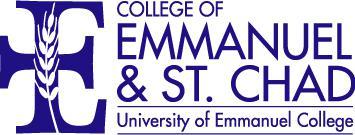
At Synod, Dr. Luke asked these questions: “Could you be a student? Do you know someone who could be a student? Can you help us get the word out? Will you continue to keep the school in your prayers? Can you help financially by making donations or bequests to the college?”
As Dr. Luke put it, “We know what we want to do; now we have to make sure we have the resources.”
(Bays, Eric, and Trevor Powell. *Emmanuel and St. Chad: A History of Training Anglican Clergy in Saskatchewan* Ottawa: Baico Publishing Consultants Inc., 2021.)
REGINA — Rev. Michael Bruce spoke of wearing two hats when he addressed synod on the afternoon of Oct. 15.
Not only is he youth and child ministry developer for the Diocese of Qu’Appelle, but he was a delegate to Provincial Synod held in Prince Albert last spring, where he was elected to the provincial executive (another hat).
In actuality, Bruce was already wearing more than one hat at the 84th Synod, as he led the orientation for firsttime members and youth delegates.
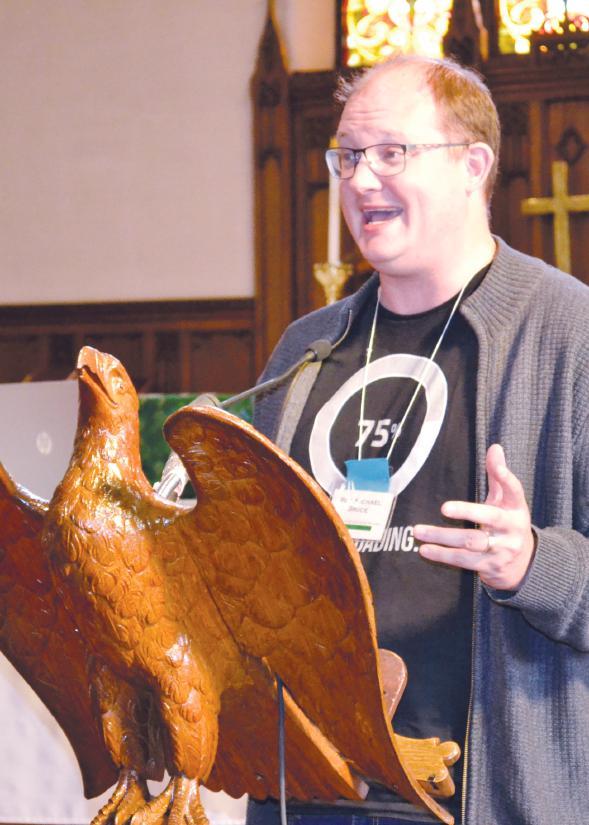
Furthermore, he helped Andrea Norberg provide the “pub trivia” entertainment after supper on Saturday night. (He and Norberg are fellow choristers, with Halcyon Chamber Choir.)
In his synod presentation, Bruce stressed the importance of making ministry to youths “a part of the DNA” for Qu’Appelle. At the same time he commended the work of Rev. Jesse Miller, assistant priest at St. Aidan, Moose Jaw, and several other active youth ministries in the diocese.
Along with exploring what is being done in Anglican parishes, Bruce was interested in seeing what other denominations are doing.
Therefore, he contacted those responsible for youth ministries within the Roman Catholic archdiocese as well as within United and Lutheran churches in our area.
At this time, he has heard back from several Lutheran churches and has been invited to join the quarterly meeting of
the Roman Catholic youth ministry support group.
In a later discussion, he said he was “trying not to build the wheel from scratch,” but aiming “to find what things Anglicans can offer, without duplicating efforts.” Ultimately the goal of all the churches is “building up youth ministry in the province.”
One initiative Bruce particularly recommended is the Canadian Lutheran Anglican Youth Gathering (CLAY), which focuses on young people in grades 9 to 12 (ages 14 to 19) and their parish leaders.
The organization describes itself as offering “worship, learning, community and fun.”
Though Qu’Appelle hasn’t been involved with CLAY up to now, other dioceses and parishes have taken up the invitation and regularly raise funds so their youths can take part. In fact, Bruce said, “there are a lot of Anglican youth there.”
The next CLAY gathering is set for Aug. 10 to 13, 2023, with the theme “Ashes and Embers.”
“So much of youth ministry is about personal relationships,” said Bruce. “It’s important (for youth) to recognize that there is community as well as opportunities to work together for common goals.”
Not only youths benefit from community. Bruce also spoke of creating a place where parents and/or grandparents can gather to learn how to support young people they know who may be experiencing high levels of anxiety.
Professional mental health workers have reported that this “lack of resiliency” has been particularly marked
after the pandemic, while young people are trying to get back to a sense of normal after the isolation and disrupted education programs caused by COVID-19.
Since ministry to youths has traditionally included summer camps, it was appropriate that the Ministry Minute following Bruce’s presentation featured a video of Camp Harding.
It was an uplifting video showing the familiar beauties of the Cypress Hills as well as engaging activities and “refurbished cabins and kitchens.”
In fact, when Bruce said, “Camp Harding is in a renewal phase” and “the diocese is deciding how it can be used in a revitalized way,” these images appeared to provide the evidence.
As well as describing some avenues being explored, Bruce said that he is available, on the first Sunday of every month, to speak to individual parishes about ministries to youth.
Please contact him at fr.mbruce@gmail.com if this is of interest to you.
Besides being responsible for youth ministries, Bruce has a half-time ministry position with Plain and Valley Parish, which includes All Saints, Pense; All Saints, Lumsden; and (in summer) St. Nicholas, Kennell.
REGINA – The 84th Synod of the Diocese of Qu’Appelle concluded with a brief business session on the morning of Oct. 16, followed by Eucharist in St. Paul’s Cathedral.
The final Ministry Minute was a video of Stephen Kennedy describing his experience as a spouse at the Lambeth Conference, held in the summer of 2022.
He said that the worship was very powerful, and the event gave the spouses the chance to meet others who share the experience and challenges of being the husband or wife of an Anglican bishop.
Following the video, Bishop Helen Kennedy described her time at
Lambeth. She said it was a fabulous experience, but regretted that the “bishops’ stream” did not have the variety of the spouses program.
She told how bishops had met, virtually, in small groups for Bible study on 1 Peter, in the months leading up to the conference. At the first session, bishops introduced themselves and said how long they had been a bishop.
Her answer was, “Three weeks.”
Bishop Kennedy said that the secular “media frenzy around the conference did not reflect what I was experiencing.”
Despite their differences, all the bishops showed “an incredible amount of respect” for each other. Secular
media focused on the differing views of samesex marriage, but paid little attention to the many other topics, or “calls,” that the bishops discussed.
Kate Berringer, diocesan co-ordinator, introduced herself to the members of Synod, and

described the strategic plan and the mission of the diocese.
She said that actually articulating elements of the mission of the diocese has been surprisingly helpful in preparing a strategic plan. She also mentioned that communication is essential to the plan.
Kennedy commented that the strategic plan will “help us find the clearest path.”
Archdeacon Catherine Harper spoke briefly about the Qu’Appelle School for Ministry and Mission, and said that 73 different individuals had attended one or more QSMM courses.
Not all of them are preparing for ordination or for lay ministry.
Rev. Jesse Miller,
chair of the scrutineers committee, read the list of those elected or acclaimed to Diocesan Council and other committees and as delegates to Provincial and General Synods. (see report elsewhere in this issue)
The bishop thanked all the many people who worked at, and in advance of, the synod.
In her closing remarks, Bishop Kennedy recalled that her election as bishop had occurred exactly one year ago.
She talked of her “roller-coaster year” with many first-time experiences. She spoke fondly of visiting many parishes, where she saw “the richness of diversity with our church, and how worship works in rural and city churches.”
PRINCE ALBERT — On Jan. 10, the students found the school looking very welcoming. It had some changes that one student wrote, “I felt proud to be in such a wonderful school. The school compound was paved, beautiful flowers around it and green grass. I also liked the paint of the classrooms blue and white. I was so happy to be at school.”
Bishop McAllister College in Busheny, Uganda has some students sponsored by Canadian Anglicans because in Uganda one must pay a fee to attend school after the first six years.
Many parents cannot afford schooling. Bishop McAllister College gives children a chance to learn and prepare for university or a trade school.
The Rev. Canon Paul Jeffries (from New Brunswick), the school principal, reported that the national exams written in November and December 2021 by P-7 (Gr. 6 in Canada) S4 (Gr.10) and S6 (Gr. 12) “Entrance Exams for University” results were not as promising as in past years, but considering the children were only in school part of the year, the students performed well under these conditions.
There was a staggered re-entry once the schools were reopened so the school was filled. Finally in June 2021 all the students had returned to classes when the second wave of COVID-19 hit Uganda.
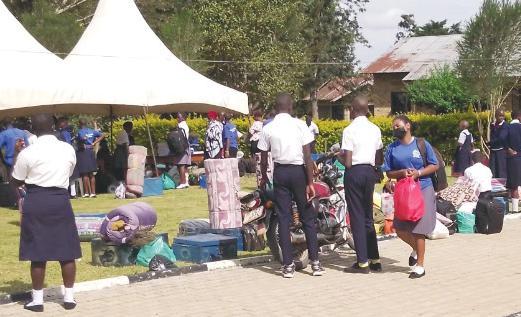

Uganda went into lock down for 42 days and the
children were sent home again.
The children live right at the school. They eat, sleep, study, enjoy sports, music and other activities.
This year school started Jan. 10. The school year usually starts the first week of February, but because of all the time the children had missed, the government added six weeks to the school year.
All students were promoted to the next level no matter how much time the child had missed.
Children who had to write national exams attended more. There were problems with the start in 2022, like getting food supplies for the children and recalling teachers.
Teachers had to adjust their lessons.
They had to start where the children were and bring them up to the level in which they were placed. The children are very happy to be learning with
their classmates and have instructors.
Workshops for teachers were organised as brief refresher courses but also to prepare teachers that there would be a great need for remedial work, and potential discipline issues they might face amongst their students, and how they might address them.
We were told to expect a dropout rate of up to 30 per cent due to teen pregnancies, early marriage, work, low morale and loss of interest in pursuing education.
The good news is that things went quite smoothly in those early weeks. At Bishop McAllister we experienced a 20 per cent dropout rate, but in some areas it has been as high 50 per cent.
All this is pretty much a rural issue where children face greater hardships and challenges.
Excelling in class Violah, a senior at Level
2 (Canada Gr. 8) wrote on July 1, Everyday this school changes, it changes more beautiful! Most parts are paved, with a green compound and beautiful flowers. I am reading so hard in order to achieve set goals. I am trying so much to please Mum and Dad.
I have put much effort in biology, chemistry and mathematics because I perform well in them and I like them so much. Mum told me to continue performing well in them because they result into a nice career.
I am also excelling in English, literature, history, geography, entrepreneurship, physics and the Kiswahili language.
In closing her letter, she wrote, My parents thank God so much because of you I can go to school. I have made very many plans to excel in my studies.
During the recent school term from February to November, Rebecca Nuwahereza, a
senior, (Gr.12) who is the Diocese of Saskatchewan ACW student, had to write national exams.
She returned to school and found stations built for sanitizing their hands. Mask wearing was a must as well as other rules to prevent COVID-19. She was very happy to be able to study with her class friends. She passed with very good marks, but without COVID-19 she most likely would have received excellent marks.
She wrote, It’s a pleasure to receive your letters here now because I have been missing your advice and wonderful words you send me.
Because of COVID-19 the school’s finances dwindled this year, as it was six weeks longer so it costed more. Children are boarded at school and food prices have gone up.
For me, Violet, it is a joy to receive a letter from a child who wants to learn. In Canada every child can attend school until they complete Grade 12.
If you would like to help financially or pay a child’s education fee (about $475 to $550 a year) this includes board and room, lessons, sports and music, you can send a cheque or money order payable to the Diocese of Fredericton.
In the interest of bookkeeping, it is essential that all monies be sent to Rosemarie Kingston, 10 Woodmill Drive, Quispamsis, N.B., E2G 1B7, 506-849-9551 or email hayser@nbsympatico.ca.
The school has finished building a library and needs books. They are fixing up the grounds. All donations are used wisely.
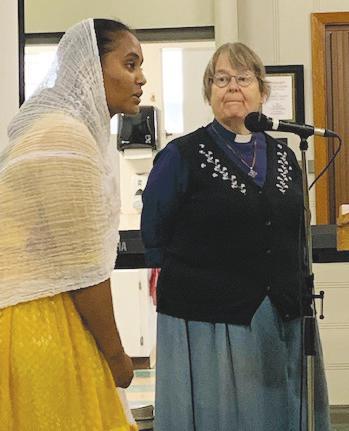
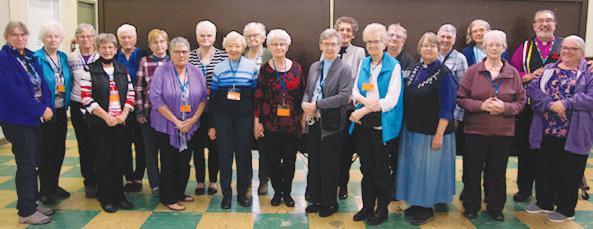 By Wilma Miller
By Wilma Miller
Editor’s note: Wilma Miller is a member of Christ Church parish and a member of the Lutheran Anglican Women (LAW).
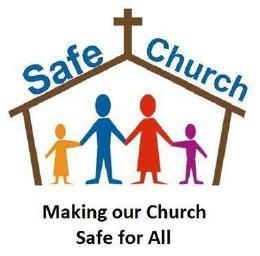
SASKATOON — The Lutheran Anglican Women’s retreat committee hosted a retreat at Christ Anglican Church on Oct. 15, under the theme of “Living in Exile” and led by the Rev. Dr. Jan BiglandPritchard, migration office co-ordinator of the Roman Catholic Diocese of Saskatoon.
Rev. Jan was the retreat leader with the musical accompaniment of Pastor Mark Kleiner of Christ Church. There were 26 women and three men. For those who were unable to attend in person the proceedings were available on ZOOM.
In the morning there were two guest speakers, Roko Walo, a refugee from Eritrea, Africa, and Bishop Chris Harper of the Diocese of Saskatoon, an indigenous man originally from the Onion Lake Cree Nations.
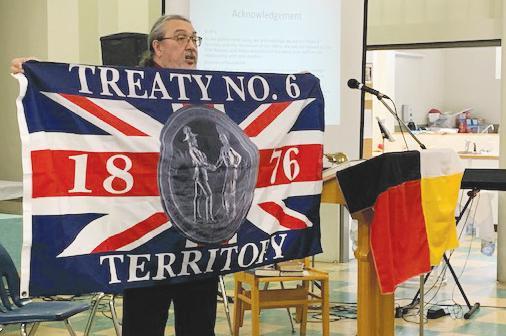
Both speakers told of their lives of trying to adjust to living and adapting in another
culture. Roko spoke on her perspective of coming from another country and Bishop Chris of how he adapted to life off a reserve in his own country.
Bishop Chris spoke to us about some important teachings for life: truth, love, faith, honesty, humility, dignity and compassion.
At noon the women ate their bagged lunches and were served refreshments as well as sweets. Roko brought a special bread she had made from an Eritrea recipe.
In the afternoon, we broke into sharing circles and shared our experiences during COVID-19, comparing our exile stories, and finding a common ground with our guest speakers’ experiences.
We were encouraged to think about walking with exiles, choosing to become pilgrims and thinking of ways to be effective Christian sisters and brothers to those living and experiencing exile.
Our closing service was led by Rev. Jan. Pastor Mark provided us with uplifting and joyful music to end our time together. A free-will offering was sent to the Saskatoon Refugee Coalition.
In his introduction to “Mere Christianity,” C.S. Lewis alludes to the controversy between Roman Catholics and Protestants over The Virgin Mary.
He wrote that, “If any topic could be relied upon to wreck a book about ‘mere’ Christianity – if any topic makes utterly unprofitable reading for those who do not yet believe that the Virgin’s Son is God – surely this is it.”
C.S. Lewis makes a good point. When it comes to proclaiming the Gospel to those who have not received it, focus on the person and work of Jesus Christ: His baptism, preaching, teaching, miracles, suffering, death and resurrection, ascension, and sending of the Holy Spirit.
In the evangelistic sermons in the Acts of the Apostles this is what you find concerning the core content of the Gospel.
But when a Christian convert is baptized, it is no longer a matter of “mere Christianity,” but entering into the Church, “which is His Body, the fullness of Him who fills all in all” (Ephesians 1:23).
The fullness of Christ that is the Church is experienced in her liturgical worship, the fasts and feasts of the church calendar, the exercise of charismatic gifts, holy orders, sacraments, and the veneration of saints, among whom the Blessed Virgin Mary is chief.
For the first 1,500 years of the Church’s history, the Virgin Mary was universally loved and venerated for her indispensable role in our salvation: bearing in her womb and giving birth to the God/Man, the person of our Lord Jesus Christ, in whom the divine and human natures were joined together, never to be divided (Article II, p. 699, The Book of Common Prayer).
But 500 years of Protestant thought has reduced Mary to something of an accessory
Icon of Mary the Guide, Conestoga Iconographic Studio.
This is a modern icon, created by Canadian Symeon van Donkelaar, who was trained and ordained as an iconographer in the Orthodox Church. He held a workshop at St. Mary, Regina a few years ago. The Greek letters are an acrostic of “Mother of God.” Jesus sticks His heel beyond the border to allude to the Genesis prophecy. Jesus
to the Incarnation: rent-awomb.
Liturgically, her role has been reduced to a cameo appearance in the annual Christmas pageant.
Once Mary has given birth, we may possibly bless her, but then politely show her the door … until next Christmas.
And yet, God has not left Himself without witness (Acts 14.17), among the young virgins of the parish, who eagerly yearn and long to play the part of Mary in the pageant. Imagine, cradling the Son of God in your arms and looking into His face … .
And so The Virgin Mary is not like a jewelry box that is thrown out once the
holds the scroll to indicate all that was written about Him in the Scriptures. He raises His hand in blessing, with three fingers for the Trinity, and two folded for the union of God and Man. His halo has a Cross and the mark of the nails. Mary is larger than Christ (“He has magnified me”) but with her hand she draws attention to her Son … Hence the title of the icon, Mary the Guide.
jewel (Christ) is removed.
For salvation is nothing more and nothing less than union and communion in the very life of God, who “took flesh from the Virgin Mary.”
Mary cannot be separated from Jesus, just as Jesus cannot be separated from Mary.
So it is that we rightly bless and magnify her whom God has blessed and magnified, and join our hearts and voices to her who “rejoices in God my Saviour,” and whose flesh joins us to God.
This union between Christ and His mother is attested to throughout the Gospels. St. Matthew
describes how the magi, on coming to the house, “saw the child and His mother Mary, and they bowed down and worshipped Him” (Matthew 2:11).
Christ is worshipped, but Mary is still in the picture. This phrase, “the Child and His Mother” appears no less than five times in the infancy narrative.
St. Luke describes how Mary and Joseph came to the Temple on the 40 th day to present Jesus before the Lord, where Simeon prophecies the sufferings of Christ, and then says to Mary, “a sword will pierce your own soul too” (Luke 2:35).
In Christ’s sufferings on the Cross, Mary suffers as well.
In John’s Gospel, Christ’s entire ministry is bracketed by the presence of His mother. At the wedding at Cana, she intercedes with her Son, and bids the servants to do whatever He tells them, thus creating a space for Jesus to act and reveal His glory.
At the cross, Jesus speaks to His mother, “Behold your Son,” and to the disciple whom He loved, “Behold your mother.” “And from that day he took her into his own home” (John 19:26-27).
So it is that union and communion between mother and Son that establishes the Church and
invites our participation. Thus we cannot speak of Mary apart from the Church, nor the Church apart from Mary.
But it is not just the Gospels that speak to us about Mary. She is to be found, along with her Son, in all the Scriptures, interpreted typologically.
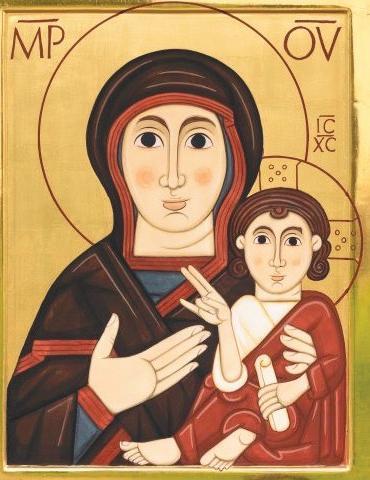
The most famous example is found in St. Matthew, who writes, “All this was to fulfill what the Lord had spoken by the prophet, ‘Behold a Virgin shall conceive and bear a son, and his name shall be called Emmanuel, which means, God with us’” (Matthew 1:23, c.f. Isaiah 7:14).
Taking our cue from St. Matthew, we search the Law, the Prophets, and the Psalms, and discover types, images and shadows of Mary, all over the place.
She features in the very first prophecy of salvation, where God says to the serpent, “I will put enmity between you and the woman (Mary), and between your seed and her seed (Christ); he (Christ) shall bruise your head, and you (Satan) shall bruise his heel”(Genesis 3:15, notice Christ’s heel in the icon!).
So it is that the Church speaks of Mary as the new Eve, whose obedience undoes the disobedience of Eve.
Further images of Mary are found in the Burning Bush (Exodus 3:3), the Ark of Covenant (Psalm 132:8), and the Queen who is both Mother and Daughter of the Davidic King (Psalm 45:9-10)
In 431 A.D. the Council of Ephesus was called to deal with the heresy of “Nestorianism,” which is the teaching that the divinity of Christ was somehow separate from the divinity of the Father, and that Mary therefore was to be properly venerated as the “Christotokos,” or “the bearer of Christ.”
In order to safeguard the teaching that Jesus is the Divine Word of God become flesh for us, the Church Fathers accorded Mary the title
 By Jenny Williams
By Jenny Williams
REGINA — The Anglican Foundation’s Say Yes! To Kids initiative brought Immanuel Parish some funding for several oneday Vacation Bible School events on days when young students are not in class due to professional development days, teacher conference, etc.
This year, Regina Public Schools declared Sept. 30 a day off, but was not
provincially. We decided to do our first School Days Off program on Sept. 30 and put together a program focusing on indigenous culture.
The program was a hit! We quickly filled our available spots and had a waiting list of about eight children.
Our day started off with an explanation of the story behind Orange Shirt Day (see www.orangeshirtday. org/phyllis-story.html).
After hearing the story of Phyllis, Rev. Diane Guilford spoke for about 15 minutes, getting kids to think about being taken away from home to attend residential school.
Our activities included hoop dancing and active games like screaming eagle. Crafts included an orange shirt pin (glitter everywhere!), using Play Doh and seeds to make mandalas, and painting rocks to honour kids who
didn’t come home.
We also did some cooking, making three sisters’ soup with squash and potatoes from our children’s garden, as well as bannock.
The children also tried spruce tea — which many of them actually liked, once they added a significant amount of sugar!
We ended the day with story time — we borrowed many books from the
library and volunteers from the parish read aloud. It was a great way to close after a busy day.
We had great support from the Immanuel congregation, with people signing up to help with all the various activities.
There were rocks left over, so on Sunday some parishioners painted rocks at coffee time after worship. The rocks are now displayed on our front lawn.
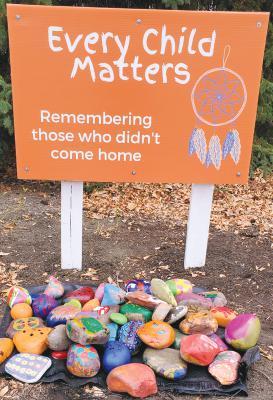
REGINA — A new altar, dedicated in memory of Bishop Duncan Wallace, has been installed in St. Paul’s Cathedral Columbarium. Wallace was Bishop of Qu’Appelle from 1998 to 2005.
The altar, designed and created by David Bryant, was dedicated by Bishop Helen Kennedy during the Requiem Eucharist on Nov. 5, the Saturday

Continued from page 20 of “Theotokos” or “Godbearer,” also translated “Mother of God.”
In declaring the veneration of Mary as “The Theotokos,” the Church established a pattern of speech whereby statements we make about Mary are also statements about Jesus.
But statements we make about Mary are also statements about ourselves.
In the same way that Mary received the seed of God’s Word and gave
closest to All Souls’ Day. The name of each person inurned in the Columbarium was read during the service.
The style of the new altar is millennia old. The simple, sturdy construction of the trestle base and the thickness and durability of the work surface would not be out of place in a carpenter’s shop 2,000 years ago.
Tau and Roman crosses are suggested in the design
Birth to God, so it is with us who, through the Gospel, give Birth to God in our souls, and so become participants in the Divine Nature. (2 Peter 1:4).
What is the Divine Nature? It is self-emptying love (Philippians 2:7).
Who was the first person to do this, and our model? The Virgin Mary.
It is for this reason that Mary occupies a special place in the liturgical life
of the Church.
In the daily service of Evening Prayer, we join our hearts and voices to Mary’s heart and voice in the words of the Magnificat, and take the joy of her salvation to be our own.
O higher than the cherubim, more glorious than the seraphim,/ Lead their praises, alleluia!/ Thou bearer of the eternal Word, / most gracious magnify the Lord. Alleluia!
(Hymn #320, Common
The Book of Common Prayer enjoins us to commemorate and celebrate Mary’s Nativity (Sept. 8), Mary’s Conception (Dec. 8), Purification (Feb. 2), Annunciation (March 25) Visitation (July 2) and Falling Asleep (Aug. 15).
The liturgical year cycle of the birth, life, death, resurrection, and ascension, of Jesus Christ, and the sending of the Holy Spirit, is enclosed in the life story
of the base, and a Greek cross is inlaid into the table top.
The colours of the white oak and Brazilian rosewood are suggestive of the elements in the eucharist.
The Columbarium is a reverential place for the repose of cremated remains. It is a serene place for visitation where one can quietly rekindle memories of loved ones.
of the Virgin Mary, showing us that her life's story nothing other than the story of our life in the Church, and that of our salvation and glorification.
(This article is a condensed version of talk given by Canon Claude Schroeder, Rector of St. Mary’s Regina, and Canon for Mission and Theology of the Diocese of Qu’Appelle on Sept. 8 as part of the “Big Questions of our Faith Series” of the Qu’Appelle School for Mission and Ministry).
One of the most exciting times of the year for me as a professor of New Testament is hosting our annual J-term course at the College of Emmanuel & St. Chad.
It’s a time when students can set aside their typical routines and attend a week-long intensive course in which we talk about the many great features of a gospel.
In 2023, we will be focusing on the Gospel of Matthew and learning more about this prolific piece of biblical literature (Jan. 9-13 from 9 a.m. to 5 p.m.).
Matthew’s gospel appears first in our New Testaments, and it was written by a Jewish man named Levi who had been a tax collector for the Roman government before he was called by Jesus.
Tax collectors weren’t exactly a popular lot, as they often collected much more money than they were supposed to.
This was an attempt to line their own pockets, so to speak, which meant that they took advantage of an already struggling financial class. The Romans hired these tax collectors, called publicani, to collect a sum of money based on what a person owned.
What someone like Levi would have done is collect
that sum and then charge extra for any number of reasons.
What is more, they would throw lavish parties at the expense of the taxpayer, and often the events of these parties were considered unsavoury according to Jewish law.
When Levi met Jesus, he was sitting at a tax booth. He was most likely counting the sums of money that he had collected and perhaps planning several ways to collect more.
The introduction of Levi is short, and what is fascinating about the story is that Jesus didn’t spend any time trying to convince Levi
to follow him; Levi got up and followed Jesus immediately after being called.
What happened to the money or Levi’s job is anyone’s guess, but there was something powerful about Jesus’ reputation and words that intrigued Levi. Said another way, there was something more satisfying about following Jesus than all the money and lavish parties could provide.
Levi is more commonly known to us as Matthew, which was his GraecoRoman name. What is more, Matthew became one of Jesus’ 12 disciples which meant that he was present for much of what is described in the gospel
story.
This gives the gospel of Matthew a unique flavour in that Matthew would not have been reliant upon another eyewitness to describe the events for him.

Instead, he heard and saw the things that Jesus said and did and then wrote them down.
What a thing it must have been to hear and watch Jesus deliver the famous Sermon on the Mount.
When Jesus began to describe the blessings, what we call the Beatitudes, it must have struck Matthew in a unique way since a tax collector could be anything but poor in
spirit, mournful, meek, righteous, merciful, pure in heart, or a peacemaker. In many cases, they were the opposite! What is more, Matthew was now able to appreciate what it meant to be persecuted for the sake of righteousness since he, no doubt, was mocked for his choice to leave behind a lavish life to follow Jesus.
One then begins to wonder just how much of the remainder of the famous sermon applied to Matthew directly.
If you are interested in hearing much more about the gospel of Matthew, and perhaps are feeling you own call towards theological education, do not hesitate to come and join the class.
You have the option of taking the class for credit, which would be applied to a degree program, or you could audit the class and soak in the information (without the hassle of doing assignments!).
You also have the option of attending the class inperson or attending via Zoom, which might make it less troublesome for travel. Either way, I would be excited to have you!
If you are interested, please contact Lisa McInnis, the college registrar, and ask for an application. Her email is lisa.mcinnis@saskatoon theologicalunion.ca
May God continue to bless His people with a knowledge of His powerful word!
Christmas is a time for generosity…. towards your family and friends, towards others less fortunate, and towards your favourite charities.
This year, our budgets might be a little tighter than usual, as we are hit with high inflation, high “supply chain” costs, new taxes, higher utility rates, and the list goes on. However, those things should not dampen our generous spirit towards our favourite charities this Christmas season.
The current economy is hitting these charities even harder than it’s hitting us! Churches are experiencing higher costs while continuing to provide quality programs and missions in our parishes and beyond.
It’s a fact that, as our parish and diocese expenses rise, the number of people and causes that need our help is rising at the same time!
When times are tough — for us, our parish and diocese, and for the many people desperate for our assistance — how can we continue to help our parish
and diocese provide these important missions when people need them most?
Let’s find ways that are “win/win” for us, our favourite charities, and for the people they support. And, if we can give ourselves a “gift” by putting these worthwhile causes on our Christmas gift list, all the better!
Here are some easy ways to do that….
The deadline to get a Donation Tax Credit receipt for the 2022 Tax Year is Dec. 31. That means that you must make
a donation prior to that date in order to receive your “gift to yourself” – a charitable donation tax credit for 2022.
Please keep in mind that there are a lot of holidays around the end of December, so it would be wise to make your donations well in advance of Dec. 31.
Your tax credit can be applied directly against your tax payable for your 2022 taxes. So, as long as you are paying tax in 2022, it really is like cash back to you for making a charitable donation.
The combined Federal/
Provincial Tax Credits rise significantly after your first $200 of combined donations, so, you can estimate that you will receive a tax credit of approximately 40 per cent ($400 on a $1,000 donation) for your donations.
You can combine your charitable donations with your spouse for the 2022 tax year. So, you can put all donations on the return that maximizes your tax credit and paying for taxes owing. Who says you didn’t give your spouse a
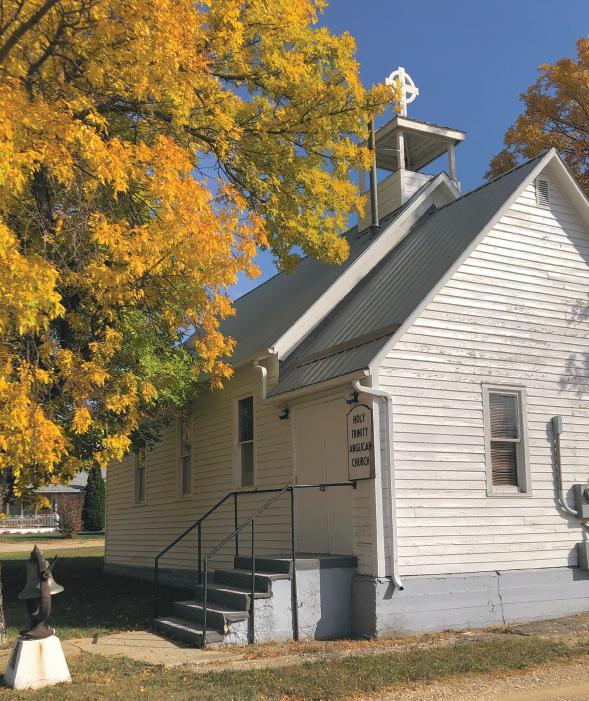 By Mary Struthers
By Mary Struthers
OGEMA (Qu’A) — On Oct. 23, Holy Trinity held a special anniversary service. Although there is great sadness to our closure, we chose instead to celebrate 110 years of Christian life and service in our community.
The service was opened by Rev. Isabella Frank and led by retired Bishop James Cowan, who had been a student minister here in 1972 and 1974. The traditional service was full of symbolism as blessings were held at the font and lectern.
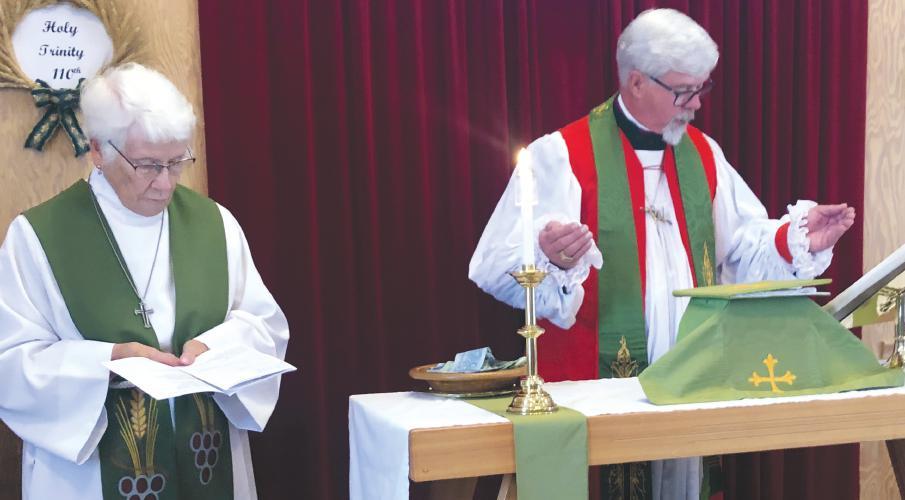
Our beautiful church was bursting as we welcomed past and present members. COVID-19 cases, stormy weather and poor road conditions played a factor as many sent regrets and three planned celebrants from Moose Jaw and Regina were unable to attend.
We give thanks to Bishop Cowan for stepping in, without preparation, and delivering a very meaningful message to us, speaking of baptisms, confirmations, weddings, and funerals, of answered prayers and success of spreading Christian life in the community.
For that we give thanks.
Everyone who attended was given a bookmark featuring a photo of the church surrounded by beautiful fall colours. The offering was given to the Bishop’s Discretionary
Fund.
After the service a lovely roast beef meal, prepared by the congregation, was served in the Ogema Museum Hall (formerly known as the Parish Hall). Warden Mary Struthers gave a brief history of the church building, the hall and the rectory.
The first Anglican service in Ogema was held in 1910 in a tent. Services were held in the ground floor of a store until the building of this church commenced in fall of 1911. By the fall of 1912 the church doors opened. The tender for building the church was $250. Holy Trinity was dedicated in October 1916.
The interior was remodeled in 1950 using
money from a trust fund. The building was raised and put on concrete footings and the entrance was changed from facing west to north. In the 1960s, pews replaced chairs. Over the years Holy Trinity has been heated by oil burner, propane and currently a natural gas heater.
In the 1970s the sanctuary was remodeled, while the current altar is the craftsmanship of John Leonard Jr. Also, during that time, the canons were changed that allowed women to be on Vestry and take a more active role in running the church.
The bell was donated by the Canadian Pacific Railroad in 1929. It was removed from the bell tower in the late 1990s due to structural weakness
Continued from page 22 gift this year?!
You can save your charitable donation receipts for up to five years before claiming them on your tax return.
This means you can give your parish or diocese a donation that they can use right away, while saving your tax receipt for more tax savings in a future year!
If you transfer some stocks or mutual funds directly (without cashing them in first) to your parish or diocese prior to Dec. 31, you receive multiple gifts in return.
First, you receive a tax credit for the full value of the investment when you transferred it.
Second, you do not have to pay taxes on any capital gains accrued on investment while you had it. This means that, even if your investment has doubled in value over the years, when you donate it to your church, not only do you get a tax receipt for its current value, there is no taxes owing on that growth!
The Saskatchewan government is issuing $500 cheques for all residents who are tax filers and over age 18 – it’s called the “Saskatchewan Affordability Tax Credit.”
The federal government is also offering cash programs to Canadians. Why not “pay forward” this money to your parish or diocese – they will get the benefit to use for their
worthy missions and you will get a charitable receipt.
Your favourite charities will be very grateful for your generosity in the Christmas season!
If you have any questions about how to maximize your philanthropic impact for your parish or diocese, your financial advisor can answer them for you, or I would be happy to, as well.
There are many other creative ways we can donate to your parish and diocese.
I would be interested to hear from you about any innovative ideas you may have! You can always reach me for comments or questions at (306) 581 – 9734 or kurtis.krug@ freedom55financial.com
and sits out front of the church. The bell was rung after the service by Jim Myren.
The parish hall was built in 1928 under the direction of T.W. Barrington and all the labour was volunteer. It was the hub of activity for Sunday school, fall suppers, wedding banquets and the home for our student ministers.
As Bishop Cowan quipped, he had the largest living room in Ogema. The hall was relocated in the early 1990s to the museum and is used very often for community functions.
The vicarage was built in 1949 under the supervision of George Howe, also with volunteer labour. In the mid 1980s an addition provided outside
access to washrooms for the congregation. The house was rented for many years and was sold in 2021.
Guests enjoyed the memorabilia display of history and photos. Struthers thanked the members from St. Peter’s, Avonlea; St Luke’s Lutheran, Ogema; and South Saskatchewan Victory Church, for their attendance with Christian support.
She also thanked Rev. Ella Frank for her past 20 years of ordained ministry in Ogema and surrounding communities.
Greetings were brought from the Town of Ogema and RM of Keywest, and a message was read from Rev. Peter Shurvin who served here in the late 1980s.
Shurvin’s words were of fond memories and of encouragement to know there is a time and season for everything. Visiting continued and a few memories were shared.
The four current parishioners cut the cake and their grandchildren served it.
Thank you to Debbie Howe for playing the organ, Dee Walker for overseeing the meal during the service, Alf Leonard for his sound system, the ladies who washed all the dishes (and reminisced of fall suppers), our families and friends and to all who have shared in the life of Holy Trinity through the years.
Dear friends, as you plan your spring 2023, consider taking a course of interest designed to equip you for any number of lay and ordained ministries. We are in this together and now we can learn together!
Ministry schools in some western and northern Canadian dioceses are working to give you in-person and online study opportunities.
Emmanuel and St. Chad College oversees and grants the Licentiate in Theology to students registered through their diocese. To register for a specific course, contact the ministry school coordinator listed for that course.
Instructors: Rev. Amy Bunce and Rev. Dr. Trish McCarthy Time: Friday, Dec. 2 from 7 to 9 p.m. and Saturday, Dec. 3, 9 a.m. to 4 p.m.
Platform: On Zoom and in person in Saskatoon Register: Rev. Dr. Trish McCarthy at trish.mccarthy@saskatoontheologicalunion.ca or (306) 370 - 8378.
Course: Preaching S.O.D.: Core Subject School: QSMM Leader(s): Rev. Iain Luke Time: Dec. 2 and 9, and Jan. 6 and 13, Feb. 3, 2023
Delivery: Hybrid Contact: Archdeacon Catherine Harper; archdeacon.catherine@sasktel. net; 306-522-3103 Prerequisites: None
2022
Course: Evangelism II CONFERENCE School: Saskatoon School of Discipleship (SOD), Core Subject
Course: NT Series School: QSMM Instructor: Rev. Dr. Dean Pinter Time: Wednesday, 7 p.m., Dec. 7 — Gospels and Acts of the Apostles
Delivery: In person and online
Register: Archdeacon Catherine Harper SPRING 2023
Course: Diocese of Saskatoon Discernment Process School: Core Subject Facilitator: Rev. Dr. Trish McCarthy with 8 - 9 people with selected experience and insight Time: Wednesday, Jan. 11, 2023 from 7 to 9 p.m. online with zoom; Saturday, Jan. 14, 2023 from 9:30 to 4:30 p.m. IN PERSON ONLY
Added info: All those discerning a call, regardless of SOD years of study Register: Rev. Dr. Trish McCarthy saskatoonschoolofdisciple
Course: I ntroduction to Spiritual Formation (ESC - PE 136) School: Core Subject Instructor: Rev. Dr. Trish McCarthy Time Frame: Thursday, Jan. 19, 2023 for 12 weeks (excl. Mar. 9) from 5:30 to 8:30;
Added Info: Includes two full-day hybrid retreats: dates set at beginning of term.
Delivery: An STU room Register: Rev. Dr. Trish McCarthy.
Course: Introduction to the Hebrew Scriptures I and II (ESC) School: Core Subject Instructor: Dr. Adam Wright
Time: Friday Jan. 27 from 7 to 9 p.m. and Sat. Jan. 28, 2023 from 9 a.m. to 4 p.m. and Fri. Feb. 10 from 7 to 9 p.m. and Sat. Feb. 11, 2023 from 9 a.m. to 4 p.m.; Delivery: An STU smart classroom. Register: Rev. Dr. Trish McCarthy.
Course: I ntroduction to the New Testament I and II
School: Core Subject Instructor: Dr. Adam Wright
Time: Friday, March 3, 7 to 9 p.m. and Saturday, March 4, 2023 9 a.m. to 4 p.m., Friday, March 17 from 7 to 9 p.m. and Satur-
day, March 18, 2023 9 a.m. to 4 p.m.
Delivery: An STU tech classroom, Zoom Register: Rev. Dr. Trish McCarthy.
Course: The Ministry of Supervision I and II (ESC – PE 351)
School: SOD Co-ordinator: Rev. Dr. Trish McCarthy
Instructors: Dr. Adam Wright, Dr. Brian Chartier, Bishop David Greenwood, Rev. Dr. Iain Luke, Dr. Becca Whitla, Rev. Dr. Kayko Driedger-Hesslein, Archdeacon Catherine Harper and Rev. Dr. Trish McCarthy
Time: Tentative Dates, Module One ,Monday, May 15 to Thursday, May 18, 2023 9 a.m. to 3:30 p.m.
Module Two Monday, June 5 to Thursday, June 8, 2023 9 a.m. to 3:30 p.m.
Delivery: STU room
Contact: Lisa McInnis esc.registrar@saskatoontheologicalunion.ca
Prerequisite: Clergy ordained over five years.
Continued from page 3
g Dec. 9-11 –
Youth Retreat Christopher Lake, ages 13-18, $50
g The following delegates were either acclamation or voted onto committees at synod:
General Synod: Reverend Rick Reed, Rev. Theresa Sanderson, Nancy Carruthers, John Rye
Court of Appeal Rev. Canon Donald Skinner, Rev. Wilfred Sanderson, Connie Jessop, John Hareuther, Ethel Rutherford
Provincial Synod Rev. Wilfred Sanderson, Rev. Dr. David Butorac, Larry Brewster, Ethel Rutherford, Carin van Walsem
Executive Committee Rev. Beryl Whitecap, Rev. Eugene Merasty, Rev. Sheila Chaboyer, Miles Nachbaur, Connie Jessop, Noreen Hareuther, Larry Brewster
Constitutions & Canons: Rev. Wendell Brock, Rev. Canon Dr. David Butorac, Caron Hallen, Miles Nachbaur
On the day of the dinner itself, make sure there’s at least one church member sitting, chatting and eating with every three guests attending.
Get to know the people who come and invite them to a Christmas service, a postChristmas Alpha course, a parents’ and tots group or the seniors craft group. Build in a way for them to give you their contact info so you can follow up with them as a church. Again, it’s all about forming authentic relationships.
If there is something the pandemic has taught us, it is that loneliness is endemic in our society. Christmas gives us a golden opportunity to host a get to know your neighbour gathering. Whether an inside wine and cheese, or outside hot choc and s’mores, Christmas can give Christians the ideal reason to invite our neighbours over.
It is out of such relationships Christians can best share with their neighbours the reason for the hope that is in them.
I know of one church on the outskirts of the Greater Toronto Area that hosted a live Nativity play on their sizable front lawn for years. A microphoned narrator told the Christmas
story while visually Joseph could be seen leading Mary on a live donkey down the suburban sidewalk, arriving at the enclosed sheep pen housing several sheep and their bath-robed shepherds.
If you do this sort of event, give your visitors something to take away such as a Christmas card with the church website on it.
The pre-pandemic rise of community choirs showed us many people love to sing, but the pandemic has largely robbed us of this. However, outside singing is still allowed! So why not have the musical members in your church to host a carol sing with the people on their street?
Be sure to include some Christmas songs unchurched people are likely to be familiar with, as well as the wonderful traditional Christmas carols that speak of our faith. By providing lyric sheets, and some handheld triangles, mini-tambourines and even kazoos, you can help even the nonmusical people on your street join in the fun.
Blue Christmas service
Christmas is traditionally a time for people to be with loved ones. But this may only serve as salt in the wound for the many people who have had someone they love die in the past year. Why not hold a short outdoor service to remember and honour
those who have died, inviting the neighbourhood to participate?
Invite people to gather, reflect and light a tea light in memory of a loved one, as church musicians play an instrumental piece. Invite them to whisper the first names of someone they know as you lead short prayers of thanksgiving and for comfort.
Once again, have some followup material to help them make a deeper connection — perhaps the dates and times for a new grief support group starting up, or perhaps copies of simple pamphlets on grieving the death of a loved one.
Food banks reported increased used during the pandemic. Many working poor (elderly workers, single parents, low-paid service workers) lost their jobs and are struggling more than ever.
Christmas is a time when many churches provide hampers of food and gifts to such people and their families. If your church does this, invite your neighbourhood to join the project.
Many unchurched people feel a bit threatened by the idea of joining a Bible study, attending a church program or coming to worship on a Sunday, but they’re only too happy to join in some form of community service.
These are some ways to unwrap your church at Christmas.
D I O C E S E O F S A S K A T C H E W A N